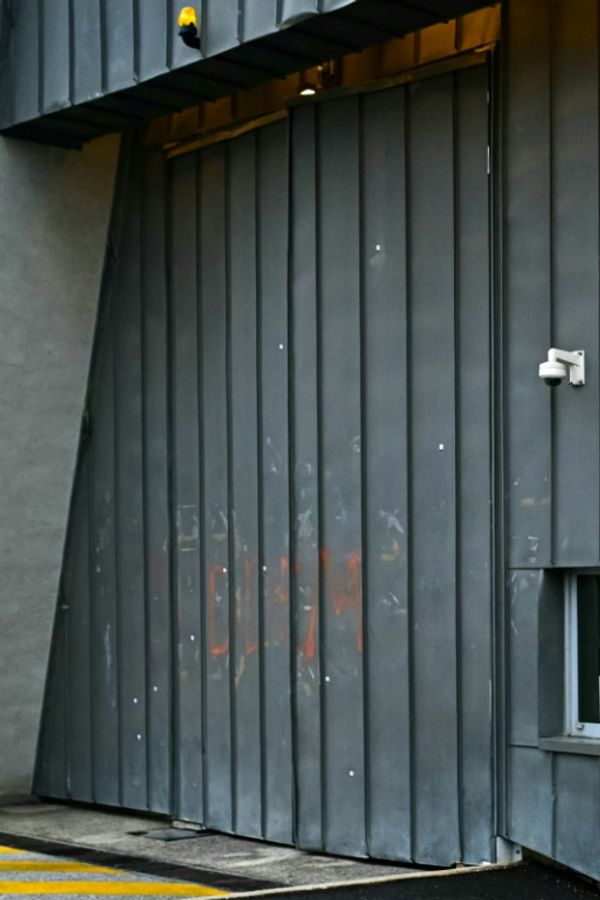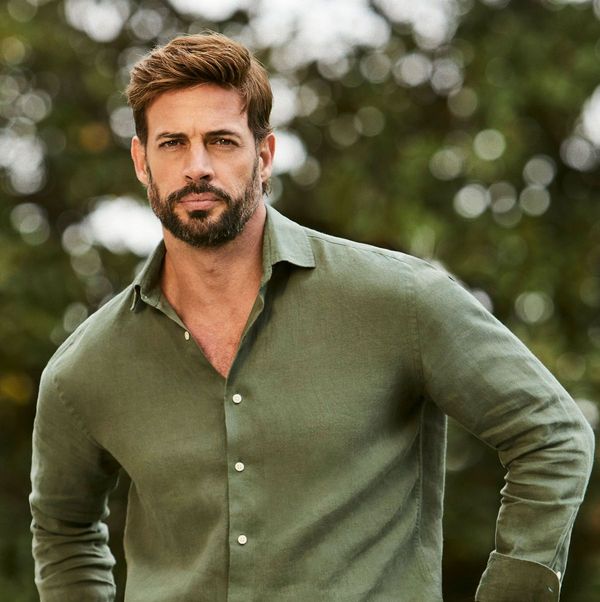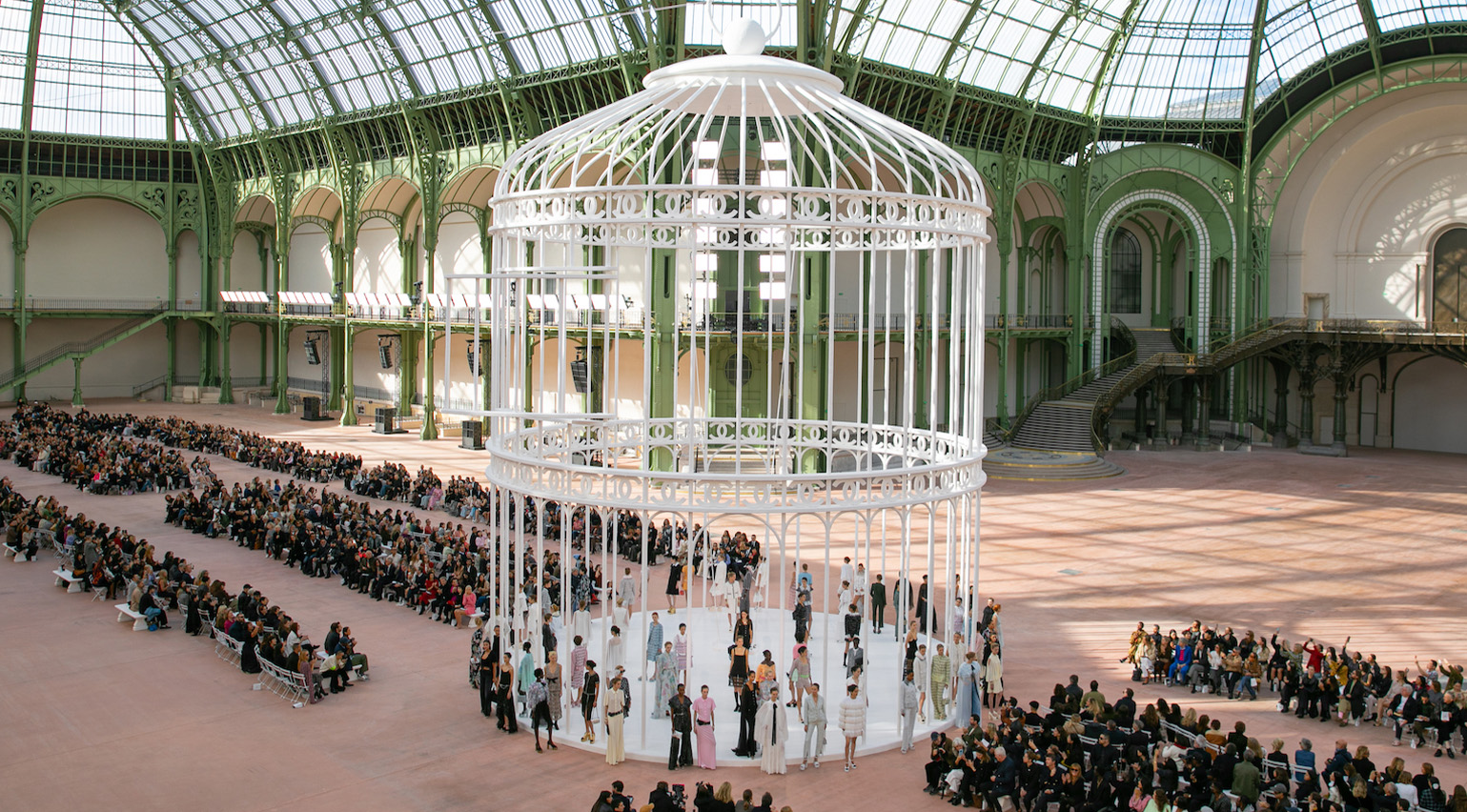
While Paris Fashion Week might mark the final stop on fashion’s world tour – with shows in New York, London and Milan already wrapped up for the season – its comprehensive nine-day schedule, featuring some of fashion’s most well-known names, meant that there was still plenty to digest before it closed yesterday evening with an exuberant show from Nicolas Ghesquière at Louis Vuitton. Exploring the idea of ‘soft power', it unfolded at the Louvre in front of an audience which included French First Lady Brigitte Macron.
Elsewhere, notable moments have included Alessandro Michele’s debut runway show for Rome-based house Valentino, which took place on Sunday afternoon on the outskirts of Paris. It marked a return to fashion for the Italian designer after exiting Gucci in November of 2022 following a critically acclaimed and commercially successful tenure in which he became one of fashion’s most well-known figures. A musing on the power of beauty, it was an evolution of the romantic, eclectic design codes he honed at Gucci, here rewritten with nods to the Valentino archive and the Roman street. ‘When I say beauty, I am clearly not referring to its universalistic, dogmatic and normative mythologisation,’ said Michele. ‘I rather allude to that unique capability to deeply feel and connect with something.’
On Wednesday, eyes were on Dries Van Noten – the brand hosted its first show since the departure of the eponymous designer – while yesterday morning, they turned to Chanel, where a creative director is still yet to be announced (the show did, however, mark a return to the Grand Palais, the spiritual home of the Chanel runway show). Numerous other big names have shown alongside, including Balenciaga, Hermès, Saint Laurent, Dior and Loewe, where Jonathan Anderson staged a ‘radical act of reduction’ on Friday morning.
Here, reported from Paris, Wallpaper* fashion features editor Jack Moss picks the best of Paris Fashion Week S/S 2025.
The best of Paris Fashion Week S/S 2025
Louis Vuitton
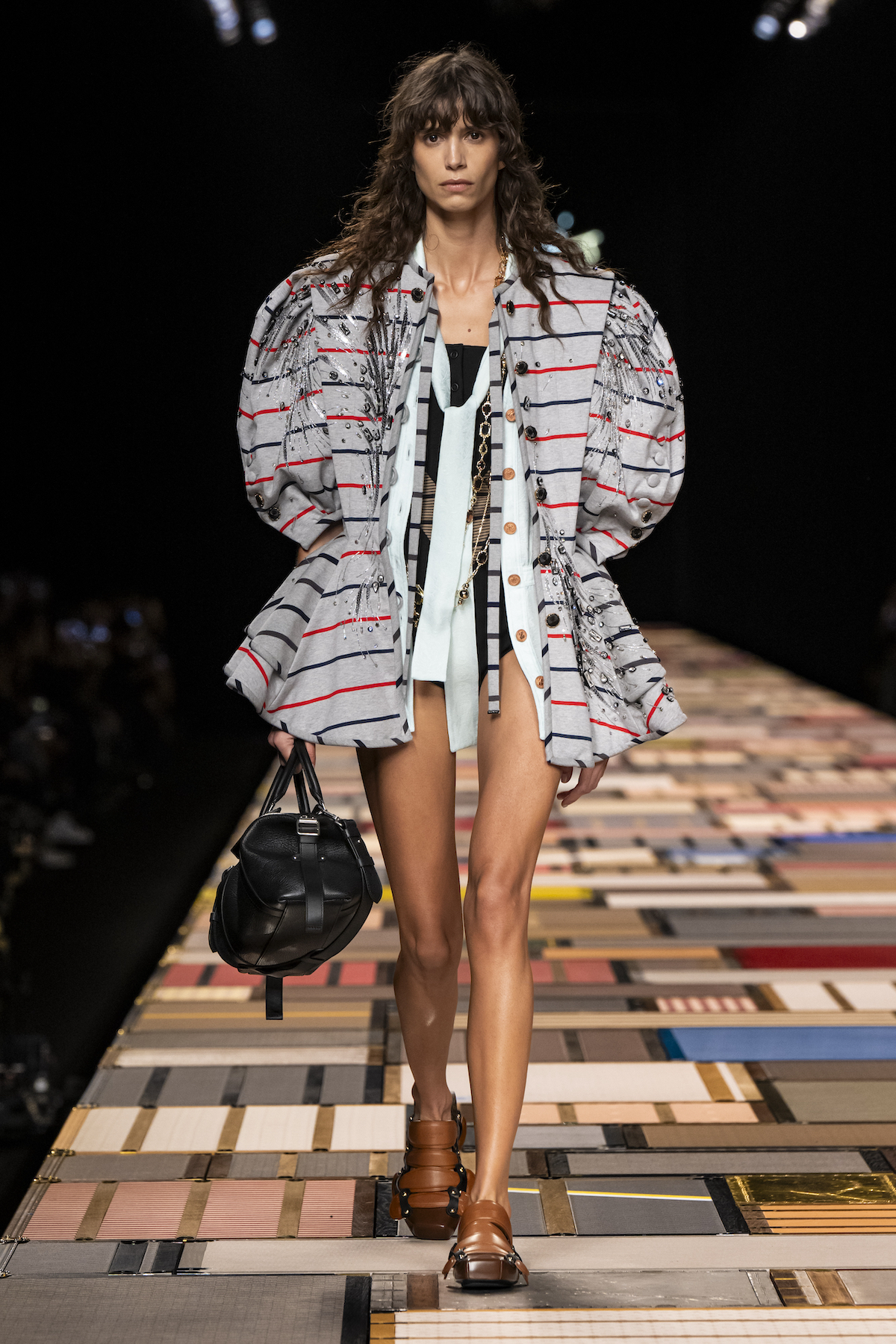
It was the perfect end to Paris Fashion Week: an uninhibited, exuberant Louis Vuitton collection from Nicolas Ghesquière, who as he enters his second decade at the Parisian house seems to be entering something of a creative renaissance. The runway, which raised upwards as the show began, appeared constructed from hundreds of hammered-together Louis Vuitton trunks, while a neon-light ‘Louis Vuitton Paris’ sign at the end of the runway recalled a golden age of full-throttle 1980s runway shows. The designer called the collection a musing on ‘soft power’, and the intriguing juxtaposition the saying captures, here figured in the opposition between structure and fluidity, soft lines and razor-sharp cuts. Or, in Ghesquière’s words (via the collection notes) ‘the suppleness of structure… ethereal opulence… resolute femininity… the mechanics of fluidity.’ There was a distinctly 1980s flair: bold, wide-shouldered jackets which flared at the waist were worn with knee-length-leggings, pirate-style pants beneath a flare of tulle (recalling the New Romantic movement), while the era’s opulence was captured in billowing gowns, a rich melange of print, and layer upon layer of jewellery. Though it was anything but nostalgic: each look came with the sheen of futurism which is so distinct to Ghesquière’s work. Meanwhile a striking white opera coat, fluid in cut and tied at the neck with a bow, was a counterpoint of elegance and restraint. Together with a euphoric soundtrack featuring songs from Jamie xx’s new album ‘In Waves’, it was an end-of-fashion-week moment that had you walking on air.
Miu Miu
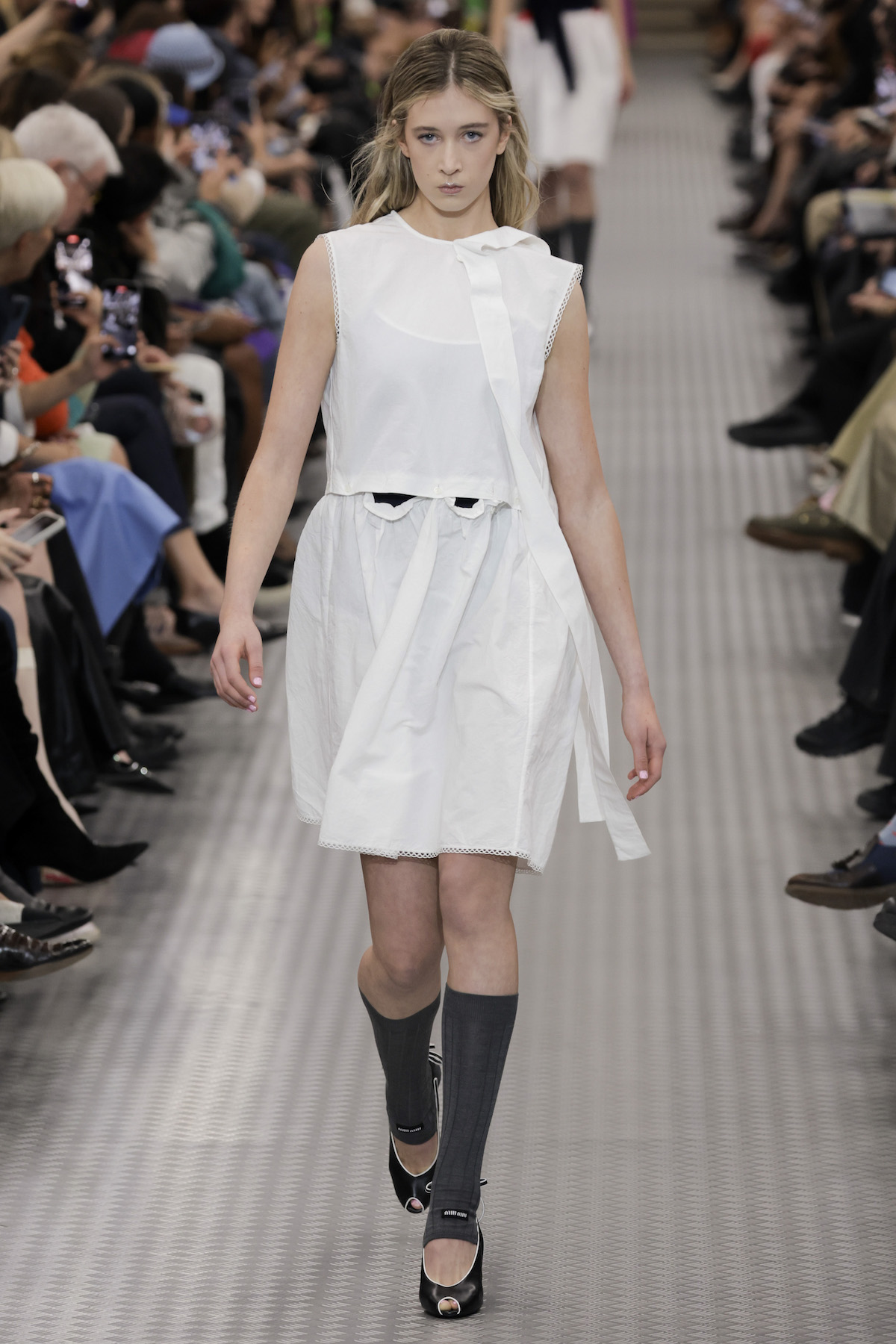
The Miu Miu show set had been created by Poland-born, London-based artist Goshka Macuga, in which hundreds of newspapers – ‘The Truthless Times’ – whirred across the ceiling as if at the printing press (the installation at Palais d’Iéna will be a part of Art Basel Paris 2024, supported by the brand). An accompanying short film – featuring sparring lovers Pathos and Lagos – took place in the newspaper’s fictional printing plant and explored themes of truth and misinformation, ‘the struggle for truth and meaning in contemporary society’. On this prescient issue, Miuccia Prada weighed in with a collection which looked towards youth for inspiration, a ‘period of absolute truth,’ said the designer via the collection notes. ‘Before dissimulation is learned, each individual is honest to themselves, to their ideals. And as a reaction to an era of overstimulation and over-information, simplicity in clothing may offer clarity and precision, and serve as an honest frame of character.’
As such, it began with the simplest of white dresses, worn by 16-year-old Sunday Rose Kidman Urban, the daughter of Nicole Kidman and Keith Urban. Other garments had a similar clarity – white cotton skirts and blouses, colour-blocked anoraks, camisole tops, pleated kilts and school blazers – though assembled with the underlying strangeness, and frisson of subversion, which runs through Mrs Prada’s oeuvre (nylon knickers, undone dresses and clashing 1970s prints, reminiscent of her S/S 2005 collection, all featured). The starry model line-up also featured Alexa Chung, Hilary Swank and Willem Dafoe – who walked for Prada’s infamous A/W 2012 ‘Villains’ show – the latter, at age 69, proving that in Mrs Prada’s world, youth is just a mindset.
Chanel
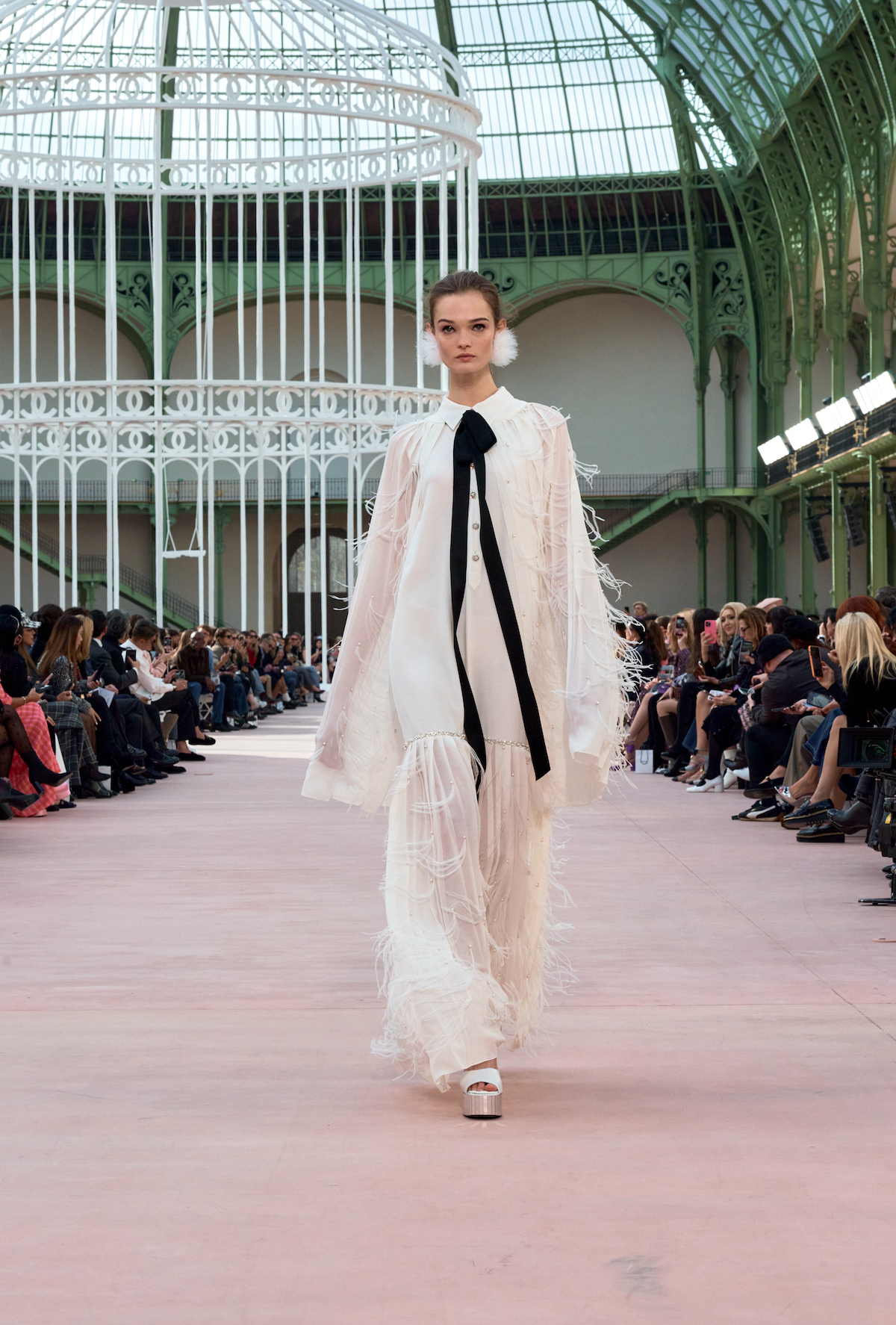
It was a return to the Grand Palais this season – the longtime home of the Chanel show – after the turn-of-the-century Beaux-Arts building underwent a renovation for the Olympics (in the time between, shows were held at the Grand Palais Éphémère across the river). The light-filled space, thanks to its vast domed glass ceiling, lent a feeling of freshness, while an enormous Chanel-branded bird cage in the centre recalled the theatrics of Karl Lagerfeld’s tenure. For spring/summer, it was again the turn of the Chanel design team to create the collection after the departure of Virginie Viard has left the house without a creative director (rumours of her replacement still swirl). Using the metaphor of a bird ‘spreading its wings beneath the glass roof of the nave’, this was a collection of ease and lightness: frilled tulle emerged from the collars of the house’s signature tulle jackets, floating organza capes were tied around the neck with black bows, and diaphanous layered knits were featherweight in construction. Meanwhile motifs relating to birds, whether delicate feather trims, or feather illustrations on silk, appeared throughout. It ended with actress-singer Riley Keough mounting a swing inside central birdcage and singing a version of ‘When Doves Cry’ – a nod to the the 1991 Coco L'Esprit de Chanel advert starring house muse Vanessa Paradis.
Balenciaga
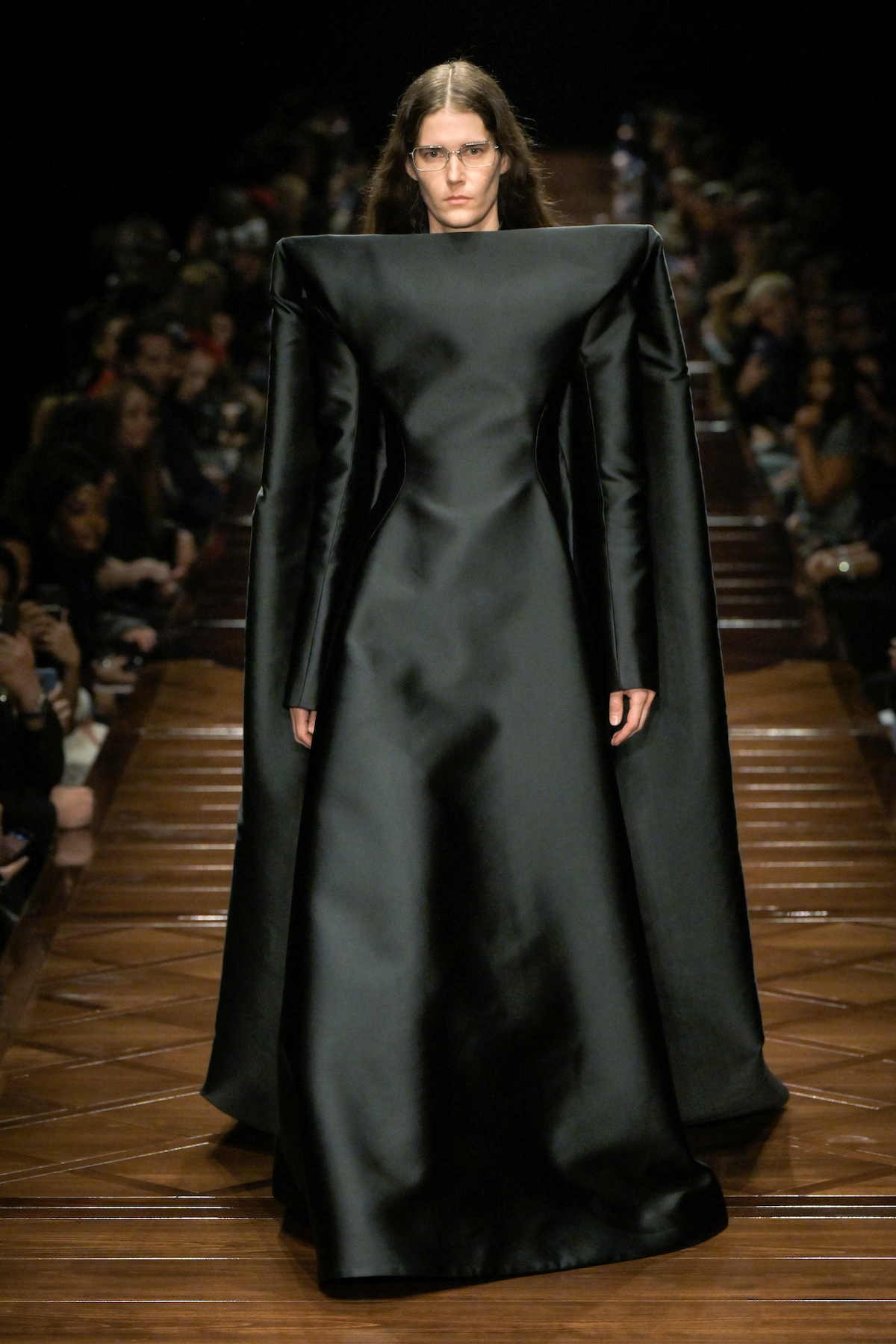
Balenciaga’s Demna distributed a handwritten note to guests this season, which outlined the designer’s desire to return to something more intuitive, an almost childlike desire to dress up and play. ‘My early memories of fashion start with me drawing looks on cardboard, cutting them away and making “fashion shows” on my grandmother’s kitchen table,’ he wrote. ‘35 years later, this show reconnects me to the beginning of my vision. It’s a tribute to fashion which has a point of view.’ In the specially constructed show space outside the Cour du Dôme des Invalides, this childhood scene was writ large: an enormous polished wood table ran the length of the space and would serve as the runway, around which guests sat as if waiting to be served a lavish dinner. Nearly submerged in darkness, the scene – in typical Demna style – was laced with a feeling of strangeness, as if a childhood memory was rising up to the surface (an amped-up version of Britney Spears’ Gimme More added to the surreal mood).
The collection’s opening looks captured the idea of placing cut-out garments onto the body: what appeared as lacy lingerie was actually trompe l’oeil motifs on a body suit. Other pieces played with proportion: dresses tied up along the back with enormous corsetry laces, left undone and trailing along after the models as they walked (they also revealed the skin of their bodies beneath). Jeans were cut perilously low on the waist – a riff on the bumster – and worn with blown-up jackets, while ‘fashion victim’ silhouettes were a playful pile up of garments, teamed with perforated caps that cleverly tilted to cover the face (in a busy Paris Fashion Week’s final days, they looked particularly appealing). Another sweater was playfully daubed with an ironic ‘Fashion Designer’ slogan, though Demna felt at his best in the collection’s crescendo of closing looks: a trio of extreme wide-shouldered jackets and dresses, which in their abundant cut and sculpted line captured something of the spirit of Cristóbal Balenciaga, albeit in Demna’s singular, uncompromising style. With its phalanx of stars and an enormous screaming crowd outside, the Balenciaga buzz felt well and truly back.
Rokh
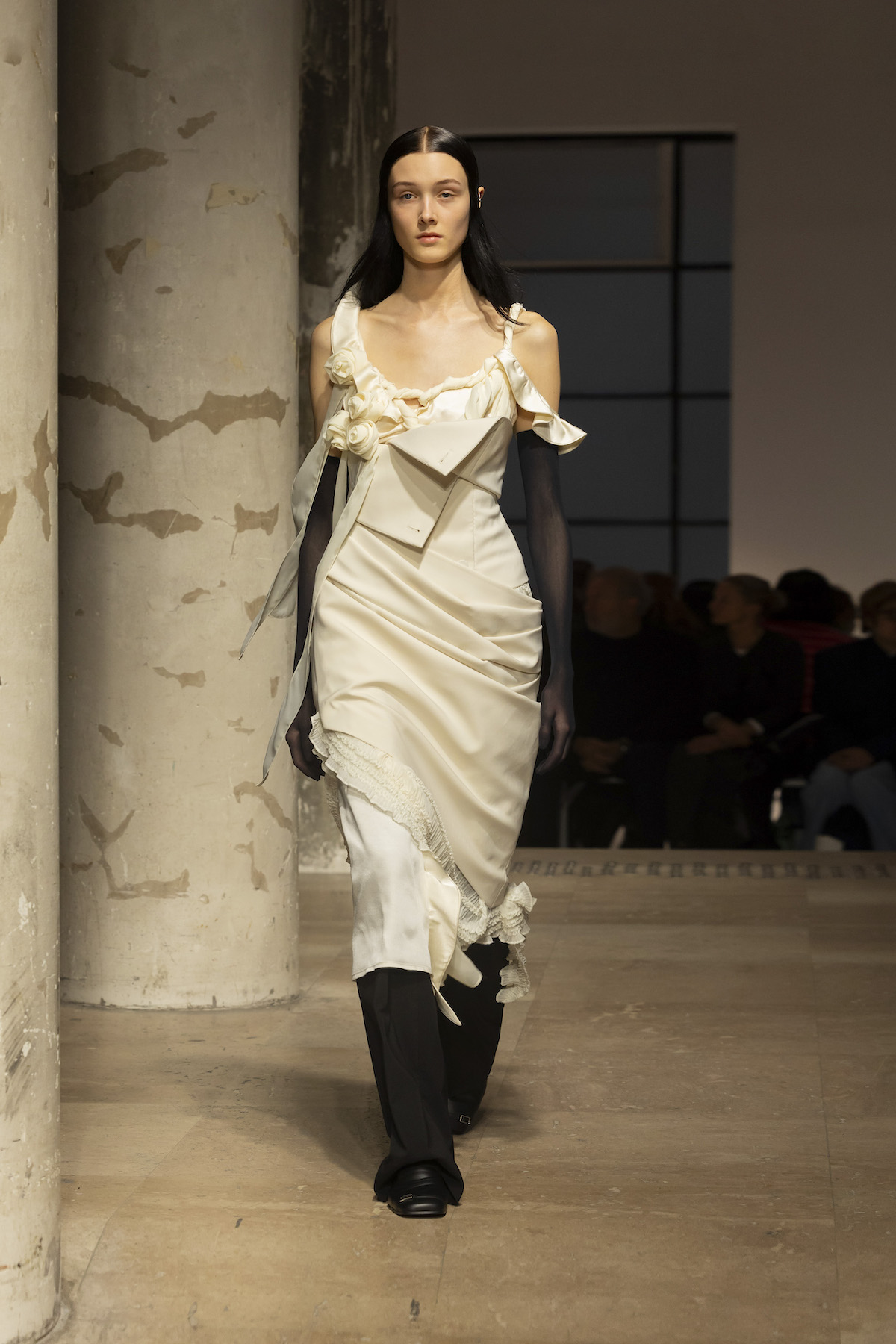
Rok Hwang felt in a more romantic mood this season, titling his collection ‘Thread Blossom’ and building it around a series of flower blossom motifs crafted from leftover fabric, lace and thread he had gathered in his studio. He described the process as ‘giving [leftovers] entirely new forms and life’, a loving act of transformation which informed a collection rich in craft and construction, from sliced tailoring – out of which delicate panels of a white shirt emerged from beneath – to intricate ruffles, folds and smocking, some adorned with trails of thread. The result was a collection both abstract and homespun, where flowers sprouted to create unexpected forms, or ruffles rippled across the body haphazardly. It was satisfying to see a greater softness this season: cardigans which buttoned open across the midriff were particularly appealing, as was a bold red sweater worn with billowing trousers, ribbed socks and ballet pumps. Hwang summarised it as a ‘celebration… of the relentless pursuit of beauty, an intricate dance of form and innovation, where the past, present, and future are interwoven.’
Sacai
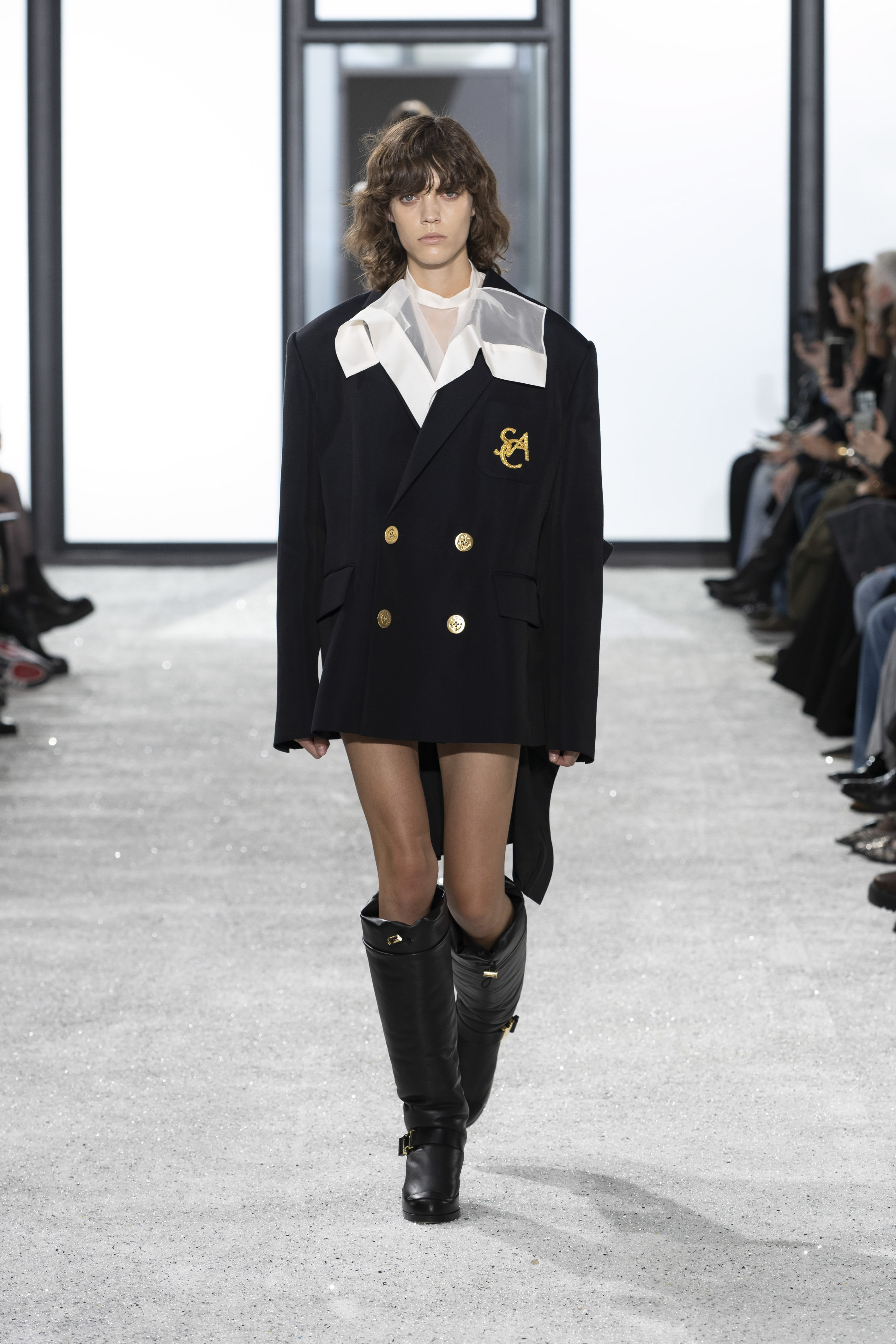
Sacai’s Chitose Abe was in a celebratory mood this season: not only was she marking an impressive quarter century in business, but she has recently opened the Japanese brand’s first Paris office on Rue Cassette on the Left Bank (after the show, she would host a ‘housewarming’ for friends of the brand). It cemented Sacai’s link to Paris, and the importance of the city as a hub for business, so some of this season’s looks – in particular a Breton-stripe motif which ran throughout – seemed like a sartorial ode to the city where Sacai shows four times a year, and to French dress codes more widely. A similar mood was conjured in the trench coats and handkerchief-collared blouses, albeit here rewritten in Abe’s distinct design vernacular, which includes unexpected pattern-cutting and hybrid garments, at once familiar and twisted. Elsewhere, Abe played with the idea of fur and skin: the latter was evoked in thousands of threads which sat on collars or sprouted from shoes, while cheetah prints were transposed onto techy nylon. Meanwhile a feeling of romance emerged in bright white ruffled gowns, constructed from layers of plissé fabric (a pitch to the potential Sacai bride, perhaps) or trails of sheer organza which sprouted in handkerchief-like layers from the back of tops. It made for perhaps a more glamorous outing from Abe this season: exciting new territory for the designer, who continues to break new ground, 25 years on.
Stella McCartney
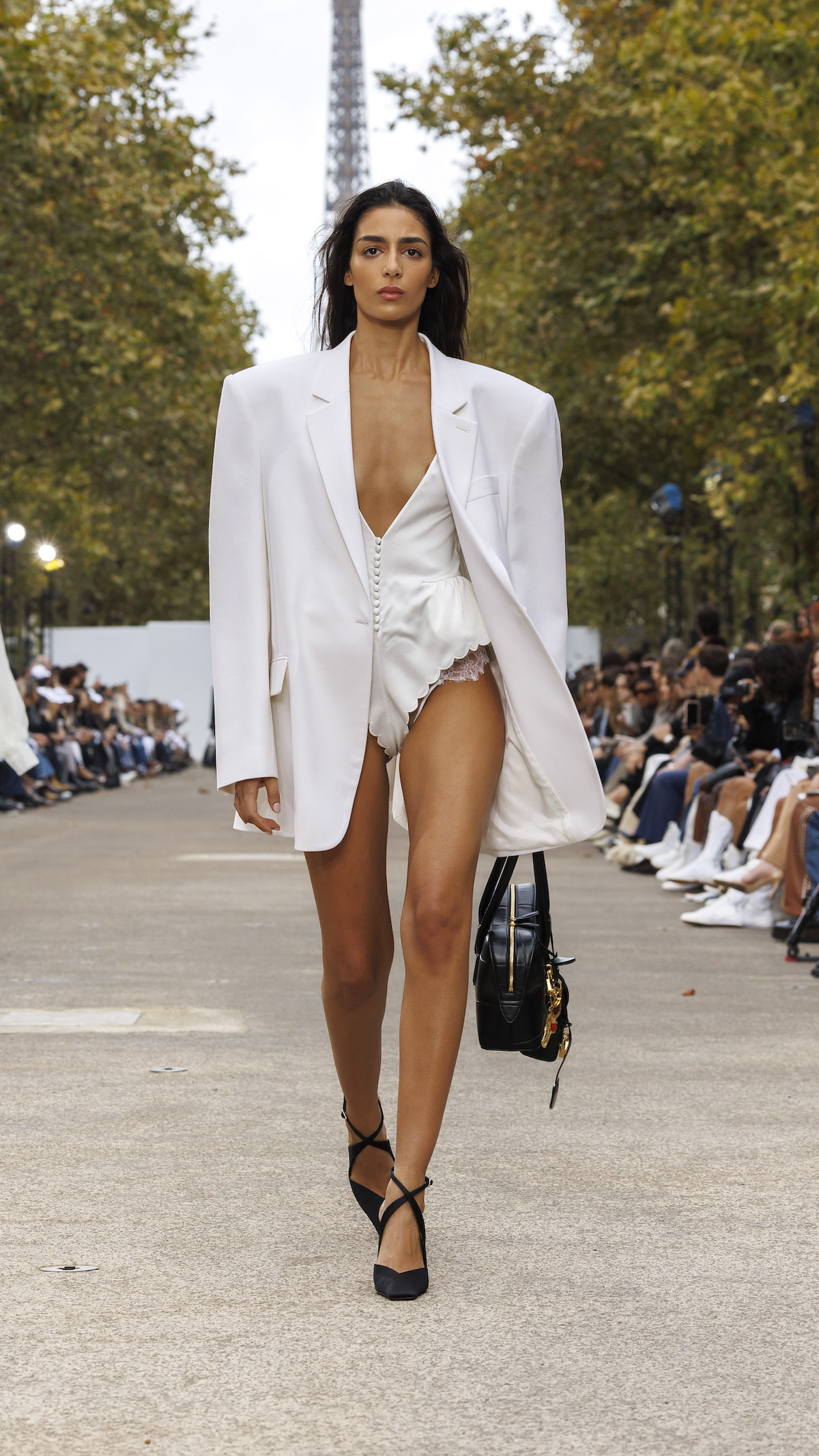
Stella McCartney returned this season to Avenue Saxe-Breteuil in Paris’ 7th arrondissement, a tree-lined boulevard which hosts an outdoor market every Thursday and Sunday (it is made all the more romantic with its direct line of sight to the Eiffel Tower). With glowering clouds overhead, by some miracle rain held until McCartney took her final runway bow, following a show that the designer once again used to spread a message about the state of the planet. Beginning with a recorded monologue by Helen Mirren inspired by author and avid birdwatcher Jonathan Franzen’s essay collection The End of the End of the Earth, it was a plea to protect birds: a ‘celebration of and call to action for birds… a collection crafted without harming a single creature’ (backstage she called to attention the number of birds killed or injured for their feathers for fashion purposes, which she said was over a billion). Soundtracked (aptly) by Prince’s When Doves Cry, the collection featured bird motifs as prints or cast as metal bra tops and necklaces, while puffy jackets – which almost recalled foam – were an alternative to the feather or fur jacket (McCartney called them ‘cloud knits’ and elaborated that they were made from recycled plastic bottles). Meanwhile the liberated collection – which featured broad-shouldered tailoring, dramatic 1980s-style trench coats, glimmering tassels, and twisting faux leather capes and dresses – was described by the designer as an attempt to capture the freedom of flight, one she said was not held down by masculine or feminine norms.
Valentino
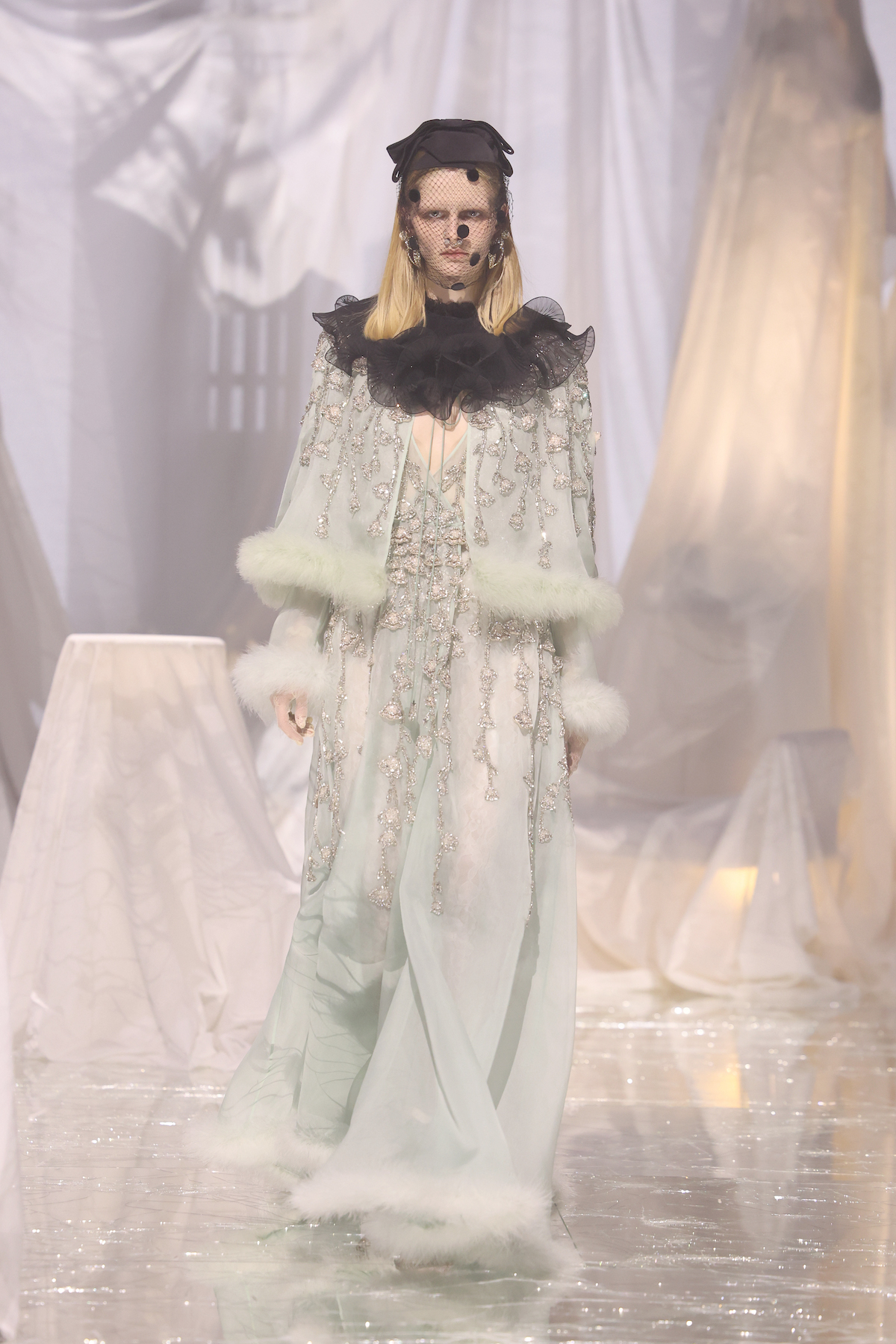
It was Paris Fashion Week’s most anticipated moment: on Sunday afternoon, Alessandro Michele – the former creative director of Gucci – staged his first runway show for Valentino, marking a triumphant return after a two-year hiatus. Held in a judo arena in Paris’ 14th arrondissement, the space was transformed in Michele’s theatrical style, seeing a jumble of chairs, furniture and lampshades covered with dust sheets, while a shattered mirrored runway looped through the space. He titled this show ‘Pavillon des Folies’, noting in his typically philosophical collection notes (Martin Heidegger, Théophile Gautier and Michel de Montaigne were all name-checked) that this was about a pursuit of beauty, albeit in unexpected, esoteric style. ‘When I say beauty, I am clearly not referring to its universalistic, dogmatic and normative mythologisation,’ said Michele in a letter distributed to guests, including Harry Styles and Elton John, who he worked closely with at Gucci. ‘I rather allude to that unique capability to deeply feel and connect with something.’
So here was Michele’s eclectic, magpie-like spirit refracted through the louche, romantic silhouettes of the Valentino archive, along with a shot of the bourgeois dress codes of Rome, where Valentino Garavani founded the house in the 1960s. There were marabou trimmed and ruffled gowns (each exquisitely constructed, leading to some excitement about his first couture collection for the house in January), polka dot tailoring and richly adorned kaftan style tops, as well as billowing floral dresses, lace tights, and moments which recalled underwear, like diaphanous negligees or bow-adorned bra tops (bows, a motif beloved by Garavani, appeared throughout). Accessories, something Michele proved to have the Midas touch with at Gucci, were particularly strong, whether vertiginous heels which tied with bow fastenings, or an array of handbags (some worn two at a time) which riffed on vintage, ladylike styles. Together, it captured the dizzying, seductive spirit of his best collections for Gucci, a flight of imagination which remained grounded in the real. Because among the more outré show pieces, this was a collection of extraordinary breadth – a wide-reaching vision for Valentino which perfectly encapsulates the eclectic, individual mood that has defined the season so far.
Read out full review of Alessandro Michele’s Valentino debut here.
Akris
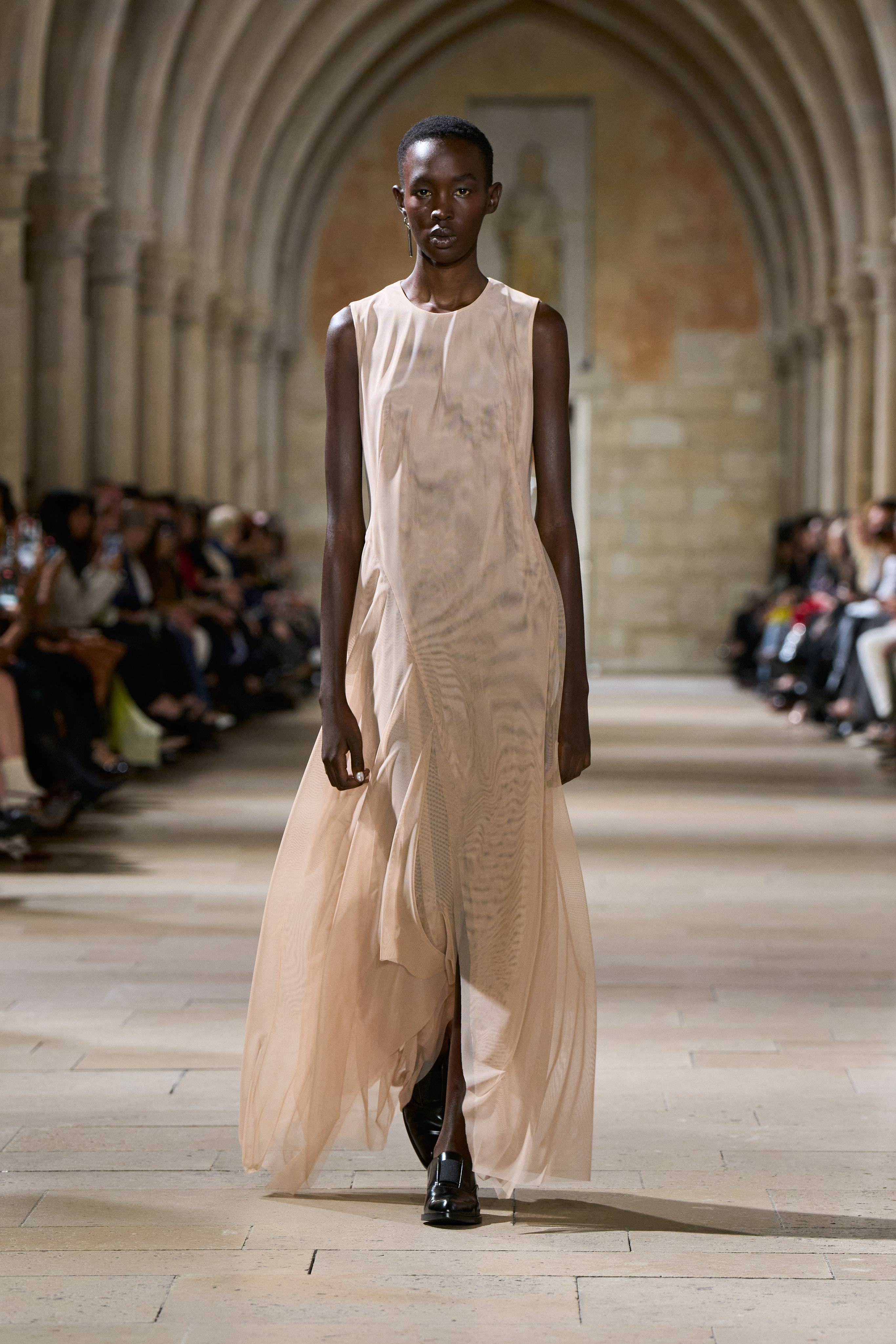
Albert Kriemler selected the serene former refectory of Paris’ Collège des Bernardin – an ancient school for Cistercian monks – to host his latest show for Akris, a space which reflected the designer’s contemplative mood for the season. Here, Kriemler was in pursuit of lightness, drawing inspiration from a recent collaborative project with John Neumeier earlier this year on the costume design for the choreographer’s final ballet as artistic director of the Hamburg Ballet, Epilogue. It drew the designer back to the works of early Renaissance artist Piero della Francesca – in particular his ‘subdued, sublime colours’, which had inspired the costumes – a period that Kriemler mined deeper for this collection. On a research trip to Mantua, Italy, he was struck by Andrea Mantegna’s 15th-century ‘Cameradegli Sposi’ fresco. ‘[It was] full of light and life: Mantegna’s use of light and shade mesmerised me, creating a visual impression of volume and granting his figures a presence that appeared individual and three-dimensional, even real,’ he said. It made for a collection which comprised delicate, oftentimes sheer layers – whether gauzy, gently draped dresses, skirts adorned with anemone-like frills, or diaphanous knits – which Kriemler described as ‘a notion of carving shape from cloth’. The mood of simplicity and reduction in the clothing was complemented by the Alice Bag, a rectangular, top-handle bag named after house founder Alice Kriemler-Schoch which captures Kriemler’s purity of line.
McQueen
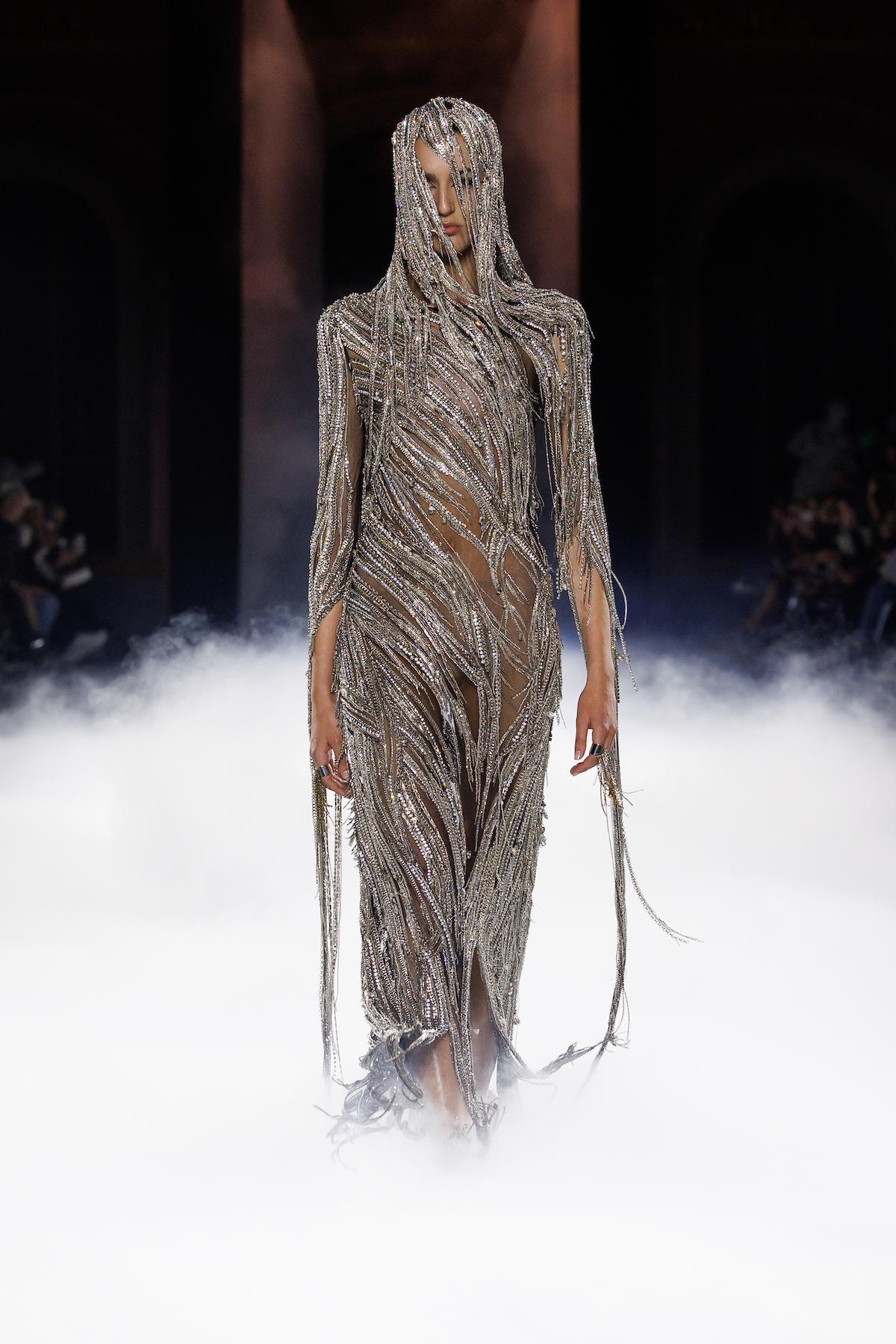
Seán McGirr’s sophomore show for McQueen took place at the École des Beaux-Arts, the set appearing like the traditional tiled floor had been hacked away to reveal a steel-plated runway running down its middle (as the show began, it lit up and filled with smoke, part of an installation commissioned for the occasion by Tom Scutt). It was an ode to the kind of runway theatrics which have long been part of the British house, here backdropping a collection which McGirr said began with tales of the shrieking banshee he had learned from his mother growing up in Ireland. It had also been an inspiration point for Lee McQueen himself, whose A/W 1994 collection was titled ‘Banshee’, a darkly romantic show staged at London’s Café de Paris. ‘The banshee is rooted in the history of McQueen,’ said the designer. ‘For me, she has come to represent something real and potent now: the idea of someone who is feeling and forthright; someone who can be seen as a guiding force.’
It began with tailoring, scrunched and gathered at the front as if its wearer had grasped it shut to protect them against the elements, while other jackets were sliced open to reveal rough gathers of tulle. This rough-cut tulle appeared throughout, including more ethereal dresses which looked hacked along their edges, while a more ceremonial flourish – enormous collars, military-style jackets – provided a regal counterpoint. Meanwhile a series of gowns, including the dramatic closing look, made entirely from metal chains and crystals, demonstrated a greater use of the McQueen atelier this season, something he credited after the show to having a full season to prepare (his debut came after just ten weeks of work). The longer preparation showed: this was a more polished, commercially savvy collection from the designer, with plenty to intrigue and desire. Though what it missed slightly was the more guttural power of Lee McQueen’s work, an embrace of the extreme which makes his archive so continually potent.
Hermès
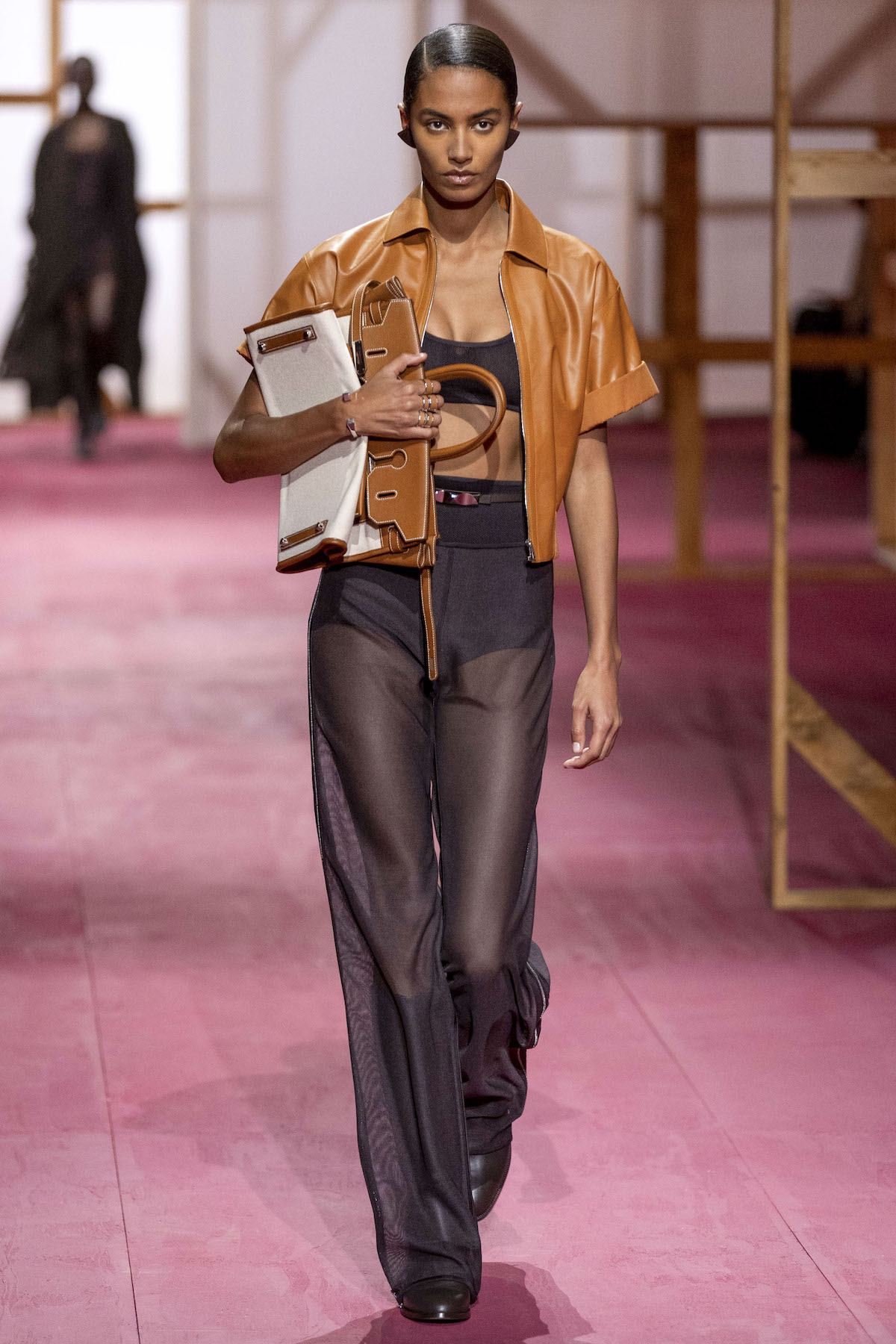
The show set for Hermès’ latest womenswear outing was a series of panelled walls, evoking raw canvasses before paint has been applied by the artist. Nadège Vanhée said that this season was about the idea of process, an attempt to capture the distinct magic of the atelier, the place where imagined or sketched garments come to life. ‘Where canvas meets brushstroke, where paper meets pencil, where raw material meets the tool wrought and refined over generations,’ she elucidated via the accompanying notes. It made for a collection of lightness, a methodical adding together of sensual layers: semi-sheer knits revealed almost sporty underwear under beneath, cropped jackets and pleated trousers came in the lightest of leather, while zips which ran the entire length of the side seam on skirts and jumpsuits. Later pieces captured the feeling of an artist at work: there were rich flushes of pink, silk shirts adorned with twisting graphic prints (she described the design as ‘between stamping and etching’), and a series of intricate dresses which appeared as if knitwear had been stitched with hundreds of pieces of leather and beads. ‘The paradox of lightness through craftsmanship,’ described the notes, summarising Vanhée’s greatest skill: despite the oftentimes hundreds of hours of craft that go into each piece, the end result is always effortless.
Andreas Kronthaler for Vivienne Westwood
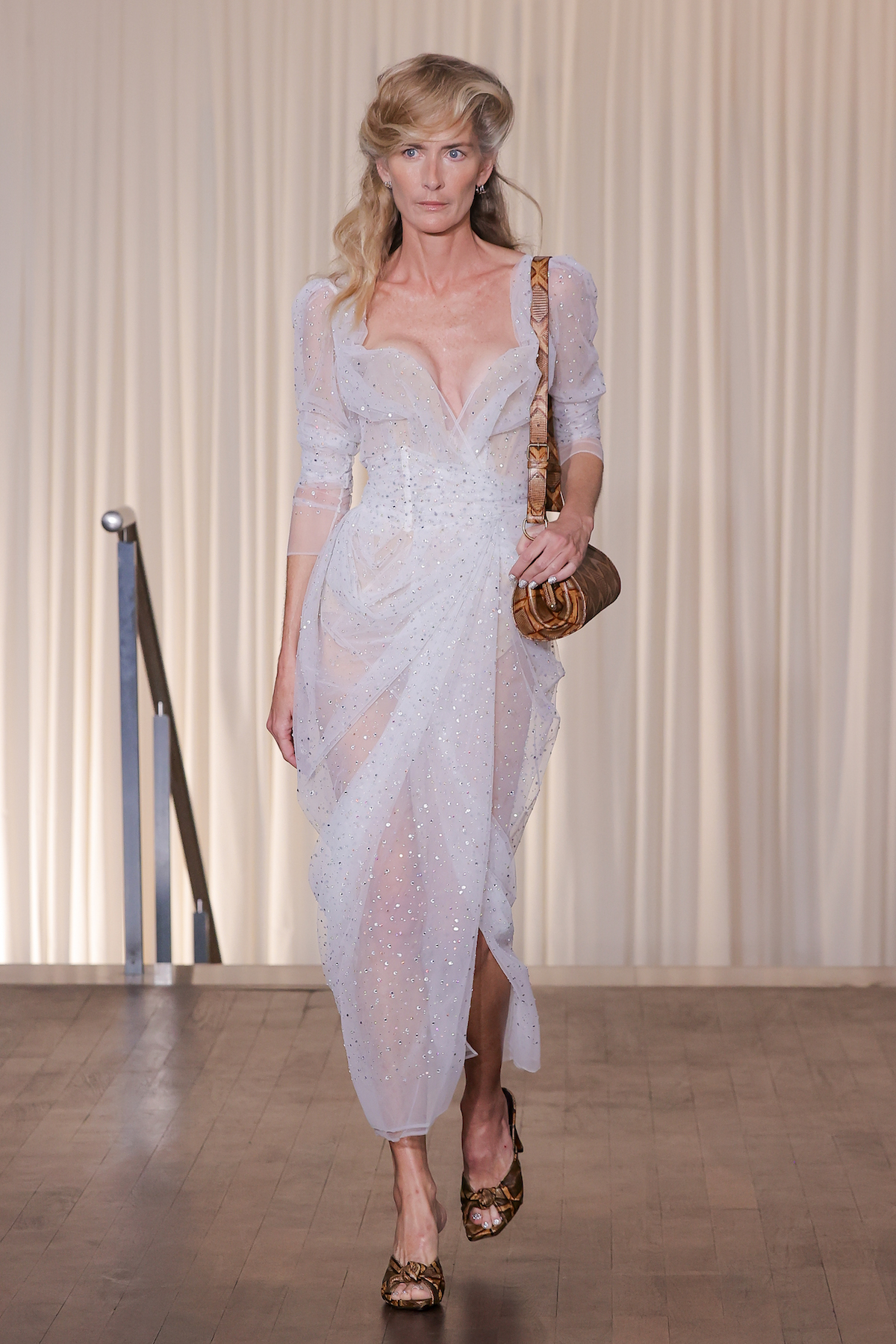
A pursuit of ‘beauty and joy’ – and a sole focus on womenswear for this season’s show – led Andreas Kronthaler to an exploration of femininity, albeit twisted in the designer’s idiosyncratic style. ‘Ultra feminine and elegant in the most classic way,’ he described. ‘The priority is the neckline. Brainy sexiness!’ Playing out in a former store on Paris’ Place de la République (the collection notes referenced its history of revolution, a founding principle of Vivienne Westwood’s own approach to fashion), models walked seductively through the corridors of seating, posing coyly on white pillars, a play on department store shows of the 1980s. There was a lightness to this season’s offering: featherweight tulle dresses, in Westwood’s signature bombshell silhouette, were dotted delicately with crystals, while diaphanous knits, cut on the bias, hung lightly on the body. Crinoline skirts came in pale, buttery yellow which Kronthaler called ‘washed out’, while white poplin dresses were surprising in their simplicity. After last season’s yodelling spectacular (complete with a staff-wielding Sam Smith) it made for a surprisingly restrained outing from the designer, though bold headwear – enormous shocks of tulle, crystal-covered straw hats – will please the die-hard fans, who gathered both in the venue and the street outside.
Junya Watanabe
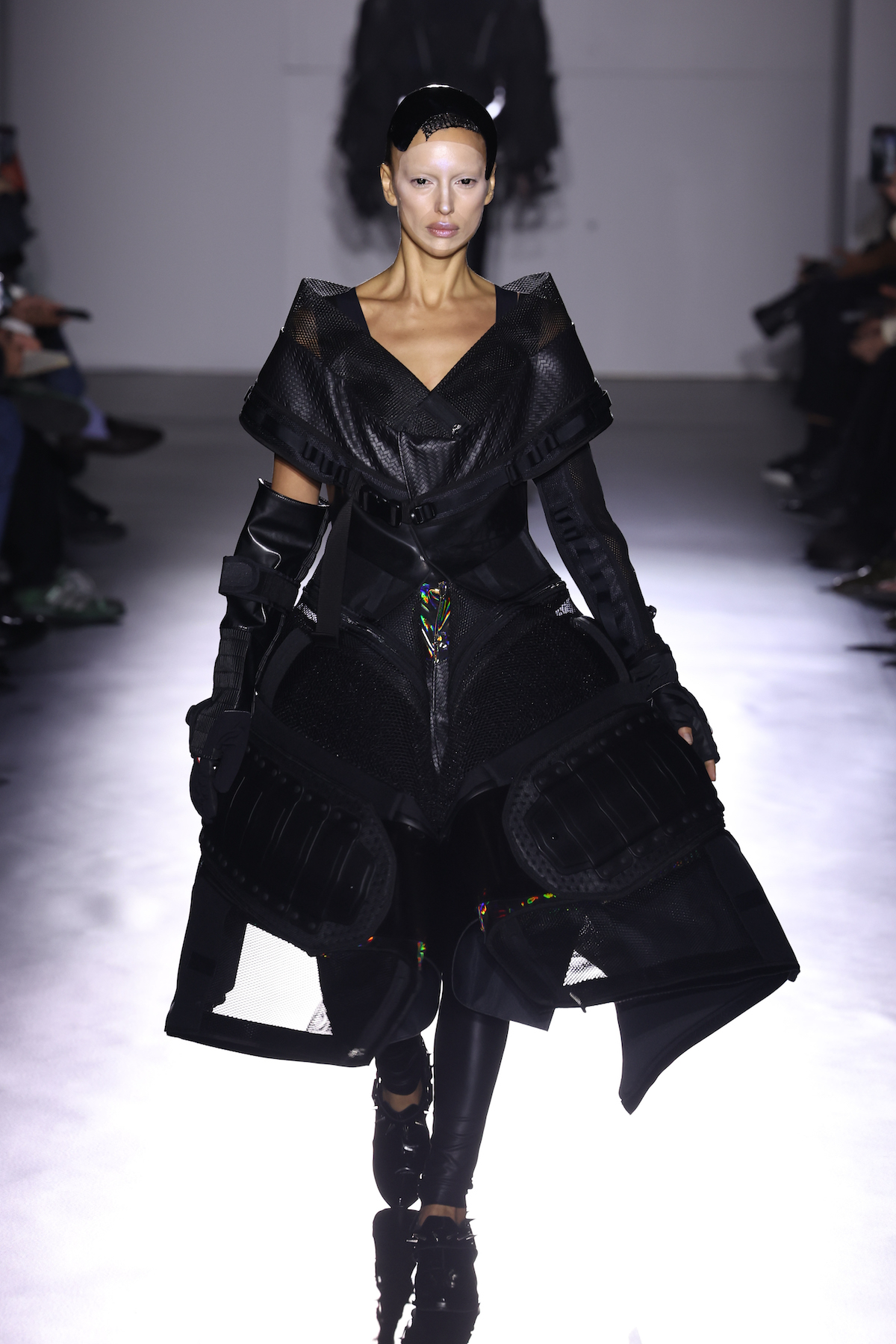
It was an energetic start to the day at Junya Watanabe, where the shimmering disco tones of Donna Summer’s I Feel Love provided an early morning wake-up call. It soundtracked a short but sweet show of futuristic, cyborg glamour, where silhouettes evocative of mid-century couture – Cristóbal Balenciaga’s envelope dress seemed to be referenced, alongside flared-waist gowns and cocooning opera coats – were reformulated in nylon backpacks, motorcycle wear or fabrics evocative of parachutes. Meanwhile gleaming reflective stripes, clip fastenings and technical straps – even the padding used to soundproof a recording studio – provided unexpected adornment (Watanabe called them ‘modern recycled materials’). Other garments, from mini dresses to wide-shouldered jackets, were constructed from stitched strips of fabric, which looped around the body to futuristic effect. It ended with the model Irina Shayk pounding the runway in an off-the-shoulder gown made from protective motorcycle clothing – techno-couture, Junya Watanabe style.
Victoria Beckham
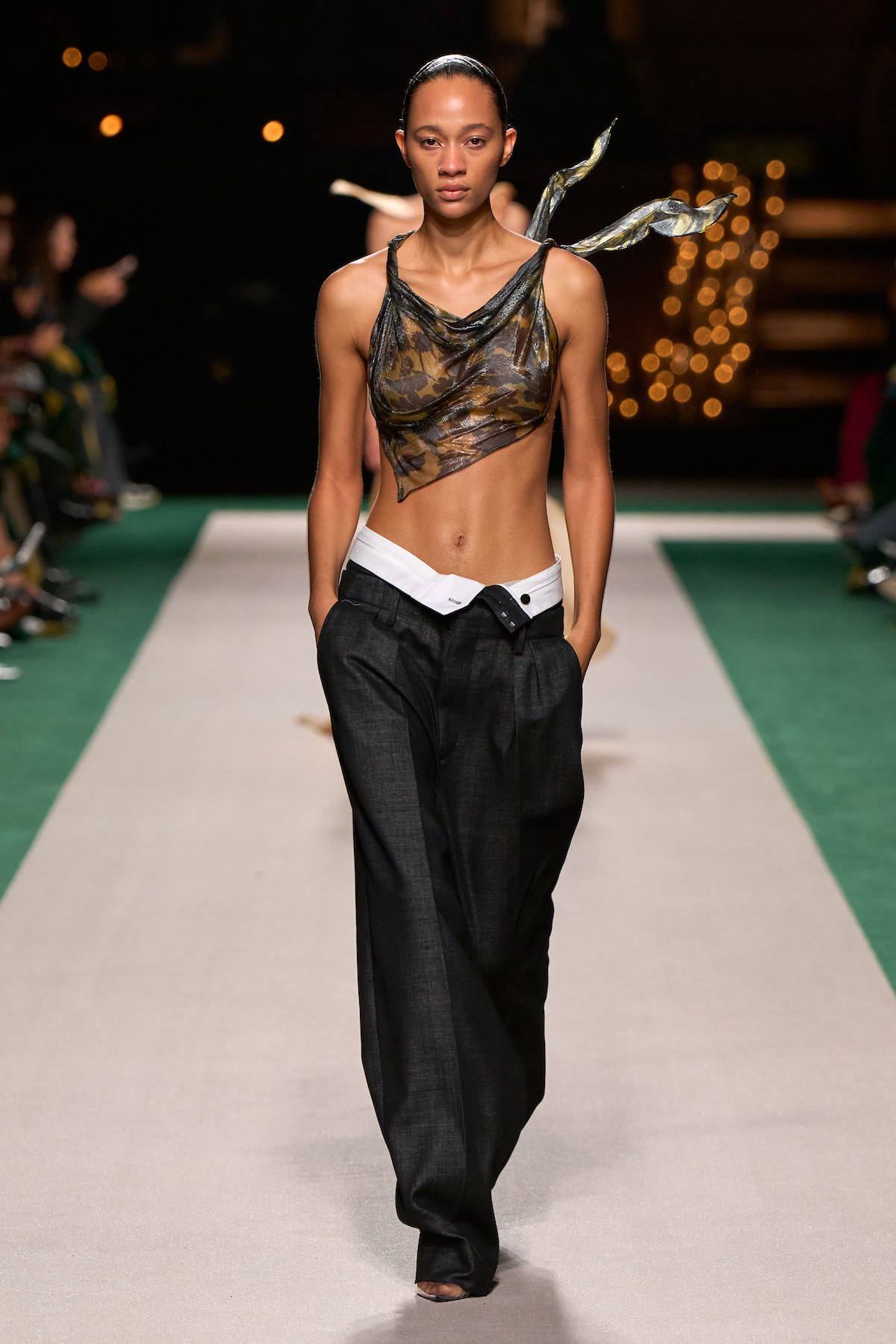
It was into the woods for Victoria Beckham, who chose to host her latest show in Château de Bagatelle, a royal folly in Bois de Boulogne, a vast forested park on Paris’ eastern reaches. It made for a dramatic setting: in the darkness of evening, guests wandered up to the showspace via a series of candlelit paths, while an enormous curved-roof tent had been erected in the grounds of the château (even the air was scented with 21:50 Rêverie, her latest fragrance, a heady reminiscence of an evening spent on the Indonesian island of Java). The evocative collection, which saw models descend from the château’s doorway and onto the runway, was an exploration of the ritual of dressing and undressing, said Beckham. ‘[Seeing] the wardrobe not only as a space in which we dress but where we undress, too… observing the physical relationship between skin and garment,’ the collection notes described. The opening looks saw fabric cast onto the skin as if doused with water, while later in the collection tailoring was sliced away and deconstructed to reveal the body beneath. A series of semi-sheer gowns, with architectural looping wires under their surface, was another intriguing proposition (and will no doubt have a few red carpet moments, judging by the evening’s starry guestlist). It is satisfying to see Beckham continue to experiment with the label – a gamble which so far seems to be paying off, with sales rising 52 per cent last year, and a Netflix documentary in the works. No doubt this runway show will play a starring role.
Loewe
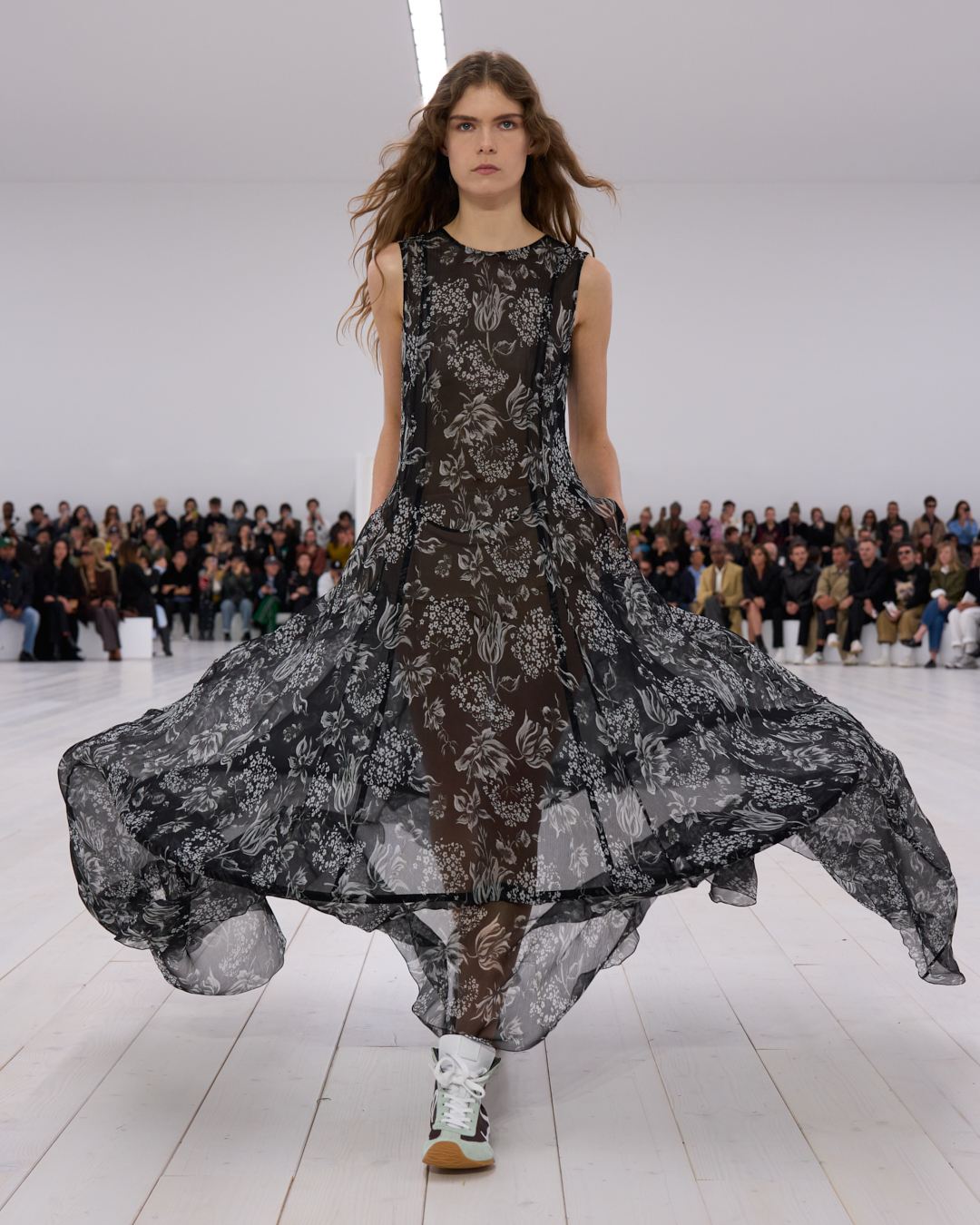
An act of ‘radical reduction’ is how Jonathan Anderson described his latest Loewe collection, which was staged in a specially constructed white box on the grounds of the historic Château de Vincennes. Around its edges it was decorated with violin sonata sheet music, while inside, a tiny miniature bird stood in the centre of the circular space like a totem. The notes elucidated that it was a 2017 work by the British artist Tracey Emin: ‘caught in a moment of pause, she encourages us to imagine the bird’s imminent flight, and ultimately its freedom’. Of the hints to music – birdsong, sheet music, and later in the collection, rockstar-style merch adorned with the faces of Bach, Mozart and Chopin – Anderson said he was wondering: ‘is it possible to fill an empty white room, commanding attention, without shouting for space?’
Commanding a space is something that Anderson has little trouble doing. Here was another collection brimming with ideas: featherweight dresses were constructed over undulating cages that bounced and bobbed down the runway in perpetual movement (the inspiration was ‘some very strange pre-war American sets’ which he found in a vintage store, here made far lighter in construction), while glimmering structured jackets were decorated with shards of shell, evocative of the exteriors of lacquered boxes. Feathers, he said, were a nod to haute couture techniques (a fixation in recent collections), while tailoring came with twisting draping on the trousers for a louche, oversized silhouette. The latter was something the designer said he had been developing for several seasons: ‘historically, tailoring was something Loewe wasn’t good at for a long time, but I think we’ve been able to do it right, and come up with a kind of signature’.
Other pieces featured the paintings of Van Gogh, including Sunflowers and Irises, the artist’s most ubiquitous works. So ubiquitous, says Anderson, that when he is driving to work he sees them over and over, imprinted on tea towels and canvases on the stalls which line the River Seine. ‘We get so used to them that they become a kind of high-low culture… we burn out the image,’ he said. Situated here, they became a new proposition, painstakingly re-painted over feathers. ‘But still we are always magnetically drawn to them,’ he continued. ‘There's something that we want to be part of, something, even if we don't understand it.’ Anderson’s work at Loewe has a similar magnetism: sometimes strange, but always seductive. After the show, he said wanted to capture the feeling of stepping into a dark room before your eyes adjust: ‘it's the idea of the eye going into focus.’ Here was a vision sharper for Loewe that was sharper than ever – a fact not unnoticed by the audience, who rose to a rare standing ovation at the end of the show.
Issey Miyake

Satoshi Kondo’s latest outing for Issey Miyake saw the Kyoto-born designer look towards the ancient craft of creating washi paper, a traditional Japanese paper made from wood bark or hemp which is used for origami, decoration and bookmaking, even clothing, thanks to its relative durability. In a glass-box-like space situated in a lush green garden in eastern Paris, Kondo and his team created an all-white scene, the floor gently creased to evoke the appearance of washi paper, and dotted with stools made from rolls of paper leftover from the heat-pressing of the brand’s signature knife pleats (usually these are sent straight to recycling, but for the showspace they were sliced to size for guests to sit on). For the collection, Kondo and his team – in what took several months of experimentation – worked alongside artisans at the Awagami Factory in Tokushima Prefecture, south-west Japan to create garments in hemp washi paper, like a gently crinkled coat which, thanks to clever pattern-cutting, folds into an entirely flat rectangle. Elsewhere, washi yarn was cleverly woven with other fabrics, while the act of folding and manipulating paper led to intricate origami-like finishes on jackets and dresses. Meanwhile a sense of play was captured in the collection’s knitwear (one pair of trousers had ‘double legholes’, as if two people could wear them at once) or the paper-bag-style handbags which for the show had been stuffed with baguettes and flowers. Kondo also noted the inspiration of water – an abundance of water is needed to make washi paper – which emerged in fluid, draped silhouettes, some of which looped over the head like a veil.
Rick Owens
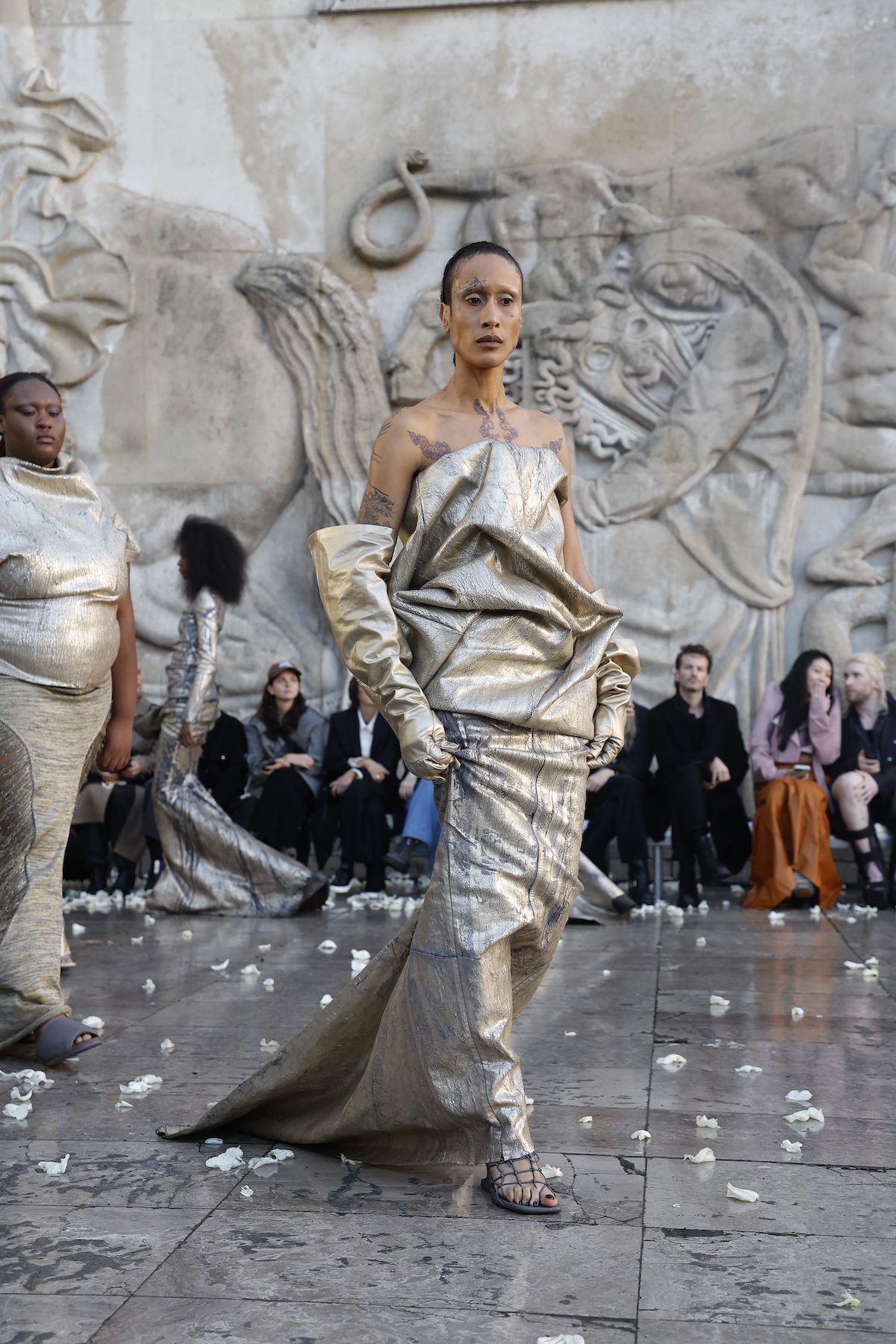
Guests were warned that the Rick Owens show, held on the outdoor forecourt of Paris’ Palais de Tokyo, would take place whatever the weather. The warning came after two days of constant rain, which – by small miracle – halted just as the show was scheduled to begin (the sun even momentarily emerged from the clouds). It was prophetic fallacy: titled Hollywood (like the menswear show held earlier this summer) this was a grasp for hope and community amid what Owens called the ‘peak intolerance we are experiencing in the world right now’. Like that menswear show, he drafted a cast of local art students to model the collection – a response, he said, to the intimacy of his previous womenswear outing, held in his Paris home – alongside underground icons like Alannah Starr and Kristina Nagel, evoking the ‘weirdos and freaks’ he found in Hollywood after escaping from small town Porterville, California to Los Angeles as a young person. ‘After showing in the house last season, I felt bad about making attendance so restricted so this time around I wanted to welcome everyone,’ he said. Here, his eclectic cast was clad in typically Owensian creations, from monastic draped gowns (some which scrunched sculpturally around the body) and operatic cloaks to tough zip-covered jackets and dramatic frilled capes he playfully called ‘megafrilled donut shrugs’. It ended with figures draped in black cloth dropping white confetti from high up on the Palais de Tokyo rooftop – a symbolic celebration of what Owens called ‘unity and reliance on one and other’.
Chloé
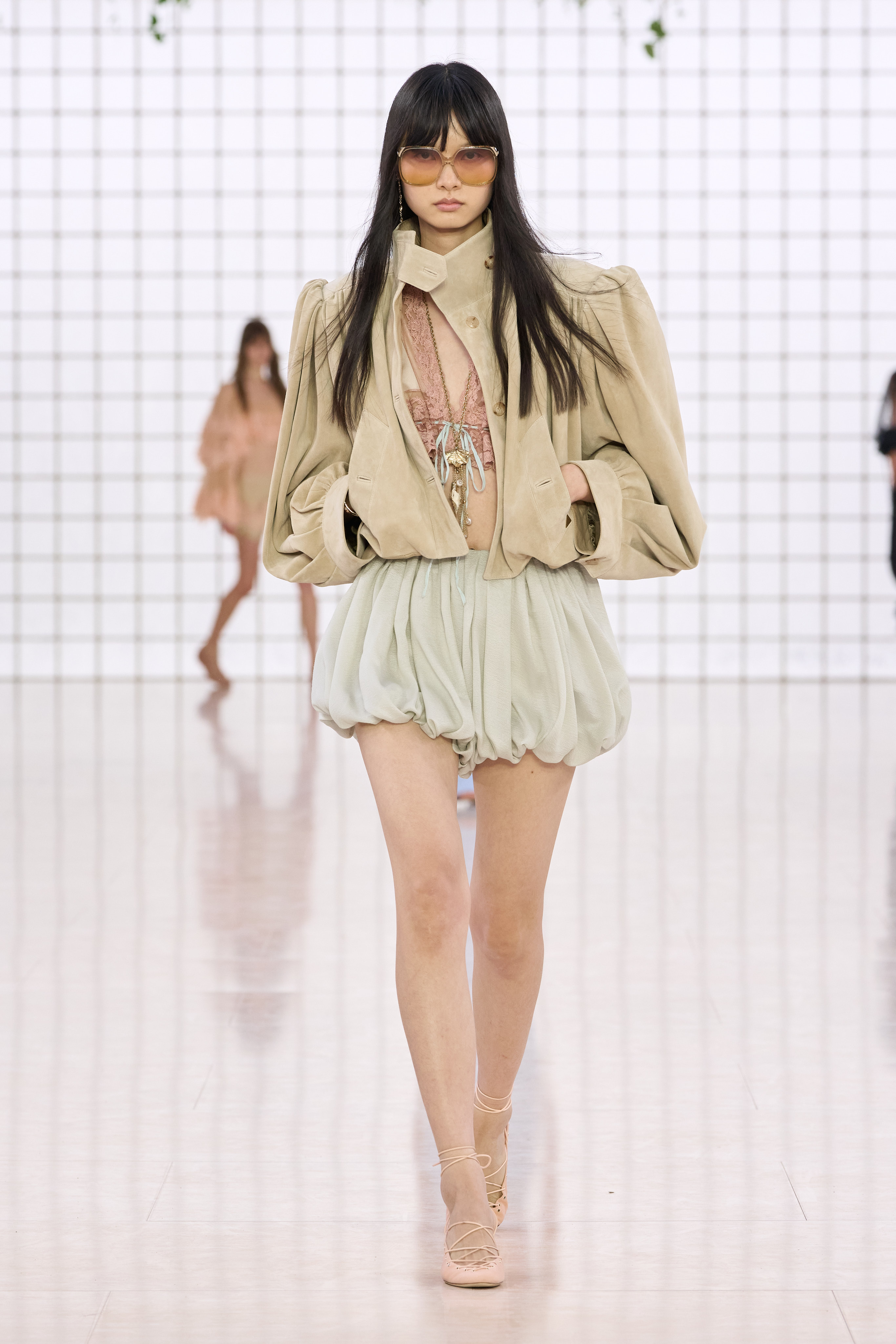
Chemena Kamali’s sophomore collection for Chloé was a continuation of the breezy, bohemian aesthetic which the German designer described at her debut earlier this year as one of ‘natural beauty, [a] sense of freedom and undone-ness… the glow, the radiance and the energy.’ It is a mood which lends itself well to the summer season, seeing Kamali conjuring an easy vision of warm-weather dressing in sheer puff-sleeve tops and body suits, billowing ruffled gowns and negligee dresses tied at the shoulder with bows. Romantic cuffs were gathered to created a floating volume, while a more sinuous line was struck in bodysuits evocative of Henley underwear, or contouring swimwear trimmed with the requisite Chloé ruffle. Colours felt bolder than last season: alongside hues of white, beige and apricot and were more vivid flushes of blue and raspberry. ‘What matters to me is the feeling and intuition that guides this very personal, intimate and sensual way of dressing,’ explained Kamali. ‘I wanted to capture that longing for summer and the way summer makes you feel – taking the essence of Chloé’s roots as a starting point, building new foundations and capturing that fantasy moment of the summer months when you reconnect with yourself.’
Acne Studios
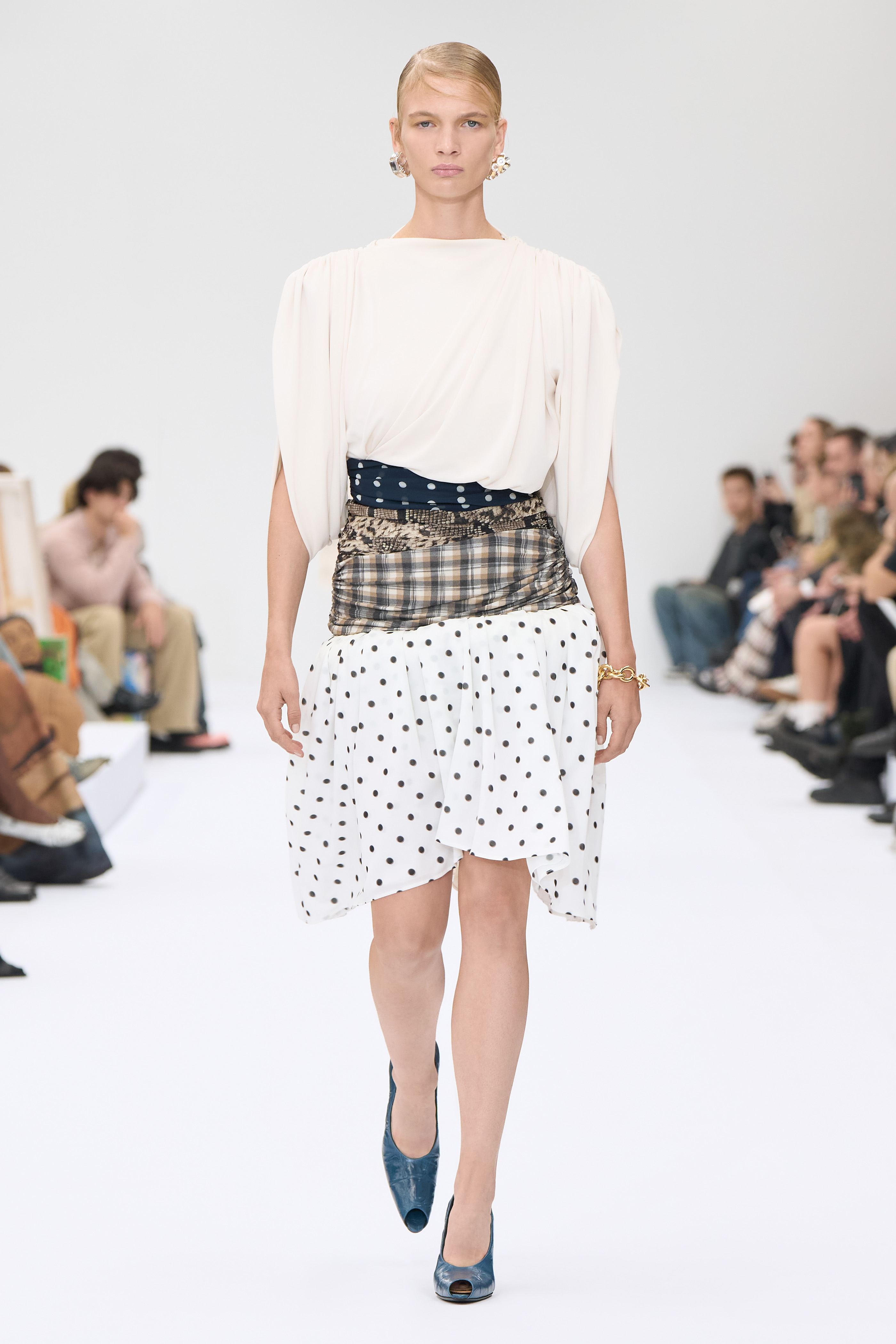
Acne Studios’ latest show took place amid an assemblage of objects by the Philadelphia-based artist Jonathan Lyndon Chase, largely comprising soft sculptures of things you might find in a home – lamps, radios, even cats – alongside recycled sofas, cabinets and armchairs sourced from LeBonCoin and daubed with the artist’s dynamic, naive motifs (the artist told Wallpaper* that the ‘messy, complicated’ domestic scene was an attempt to explore ‘emotions and the body, and how they affect the space around you’). ‘The idea for this collection started from a twisted domestic scenery. I asked myself whether classic domestic codes could actually be translated into fashion,’ explained Jonny Johansson, Acne Studios’ creative director. Promising a surreal ‘glimpse between closed doors and curtains’ at once ‘domestic and alien’, the collection itself riffed on the materials of the home – tablecloths, curtains, upholstery – reimagined in the brand’s distinctly contemporary style, whether as the enormous bows on draped dresses, or the chintzy floral motifs which adorned peep-toe boots. Intriguing too were the collection’s proportions: tailoring appeared as if it had been inflated, while other garments were shrunken in size, or nibbled with holes, as if worn and washed for years. Meanwhile dresses, crafted from pile-ups of different fabrics like discarded clothing, conjured a strange glamour.
Rabanne
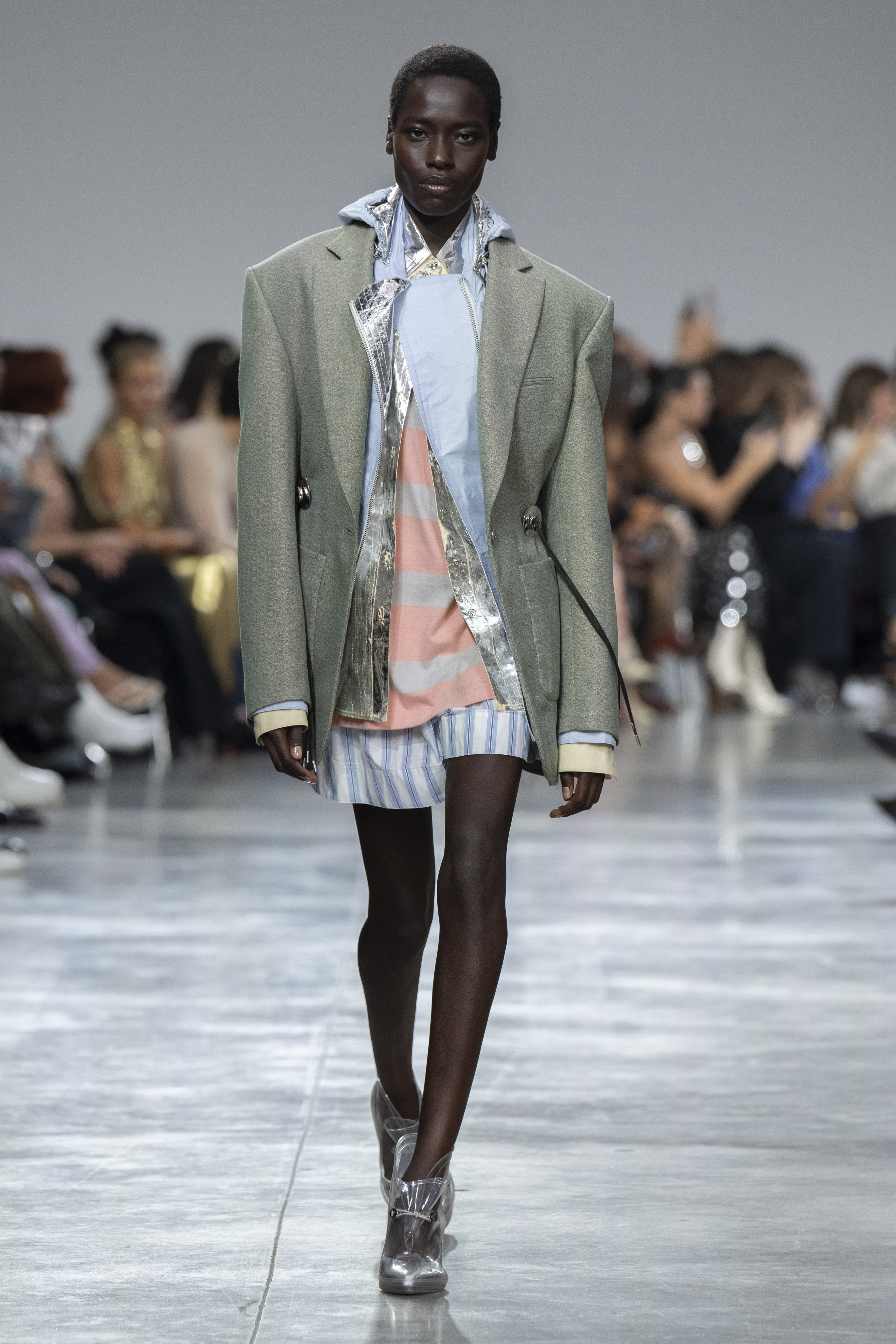
Speaking to Wallpaper* last year, Julien Dossena said that his collections begin with material, tasking his team to experiment with texture, fabric and embellishment before a single item of clothing is sketched or made. This, said Dossena, is the spirit of the house: in 1966, founder Paco Rabanne said he ‘defied anyone to design a hat, coat or dress that hasn’t been done before... the only new frontier left in fashion is the finding of new materials.’ Dossena’s latest collection, shown on a drizzly Paris afternoon, continued this approach, taking the mainstays of an everyday wardrobe – striped cotton shirts, cableknit sweaters, bomber jackets and lace-trimmed slip dresses – and reimagining them in new materials or treatments (for example the gleaming cable-knit was ‘frosted’ across its surface, while guipere lace was ‘foiled’ to otherworldly effect). Titled ‘Material Girls’, it captured what Dossena described as ‘an interplay of casual and decadent’.
Towards the end of the show were three versions of the chainmail 1969 handbag, which Paco Rabanne had originally based on the traditional steel aprons worn by butchers in France. Just as the couturier had elevated the humble into an object of desire – inspired, in part, by Marcel Duchamp’s readymades – Dossena undertook his own act of transformation. These were bags just about as precious as you could get: one was created from hand-blown Murano glass by Venice-based artisans Venini, the next from Astier de Villatte ceramics, and the final one by medal-makers Maison Arthus Bertrand. Crafted from gold and taking over 300 hours of labour, it was dubbed the ‘world’s most expensive bag’ – a tribute, said Dossena, to Paco Rabanne’s gold-and-diamond-covered ‘world’s most expensive dress’, created for house muse Françoise Hardy in 1968.
Dries Van Noten
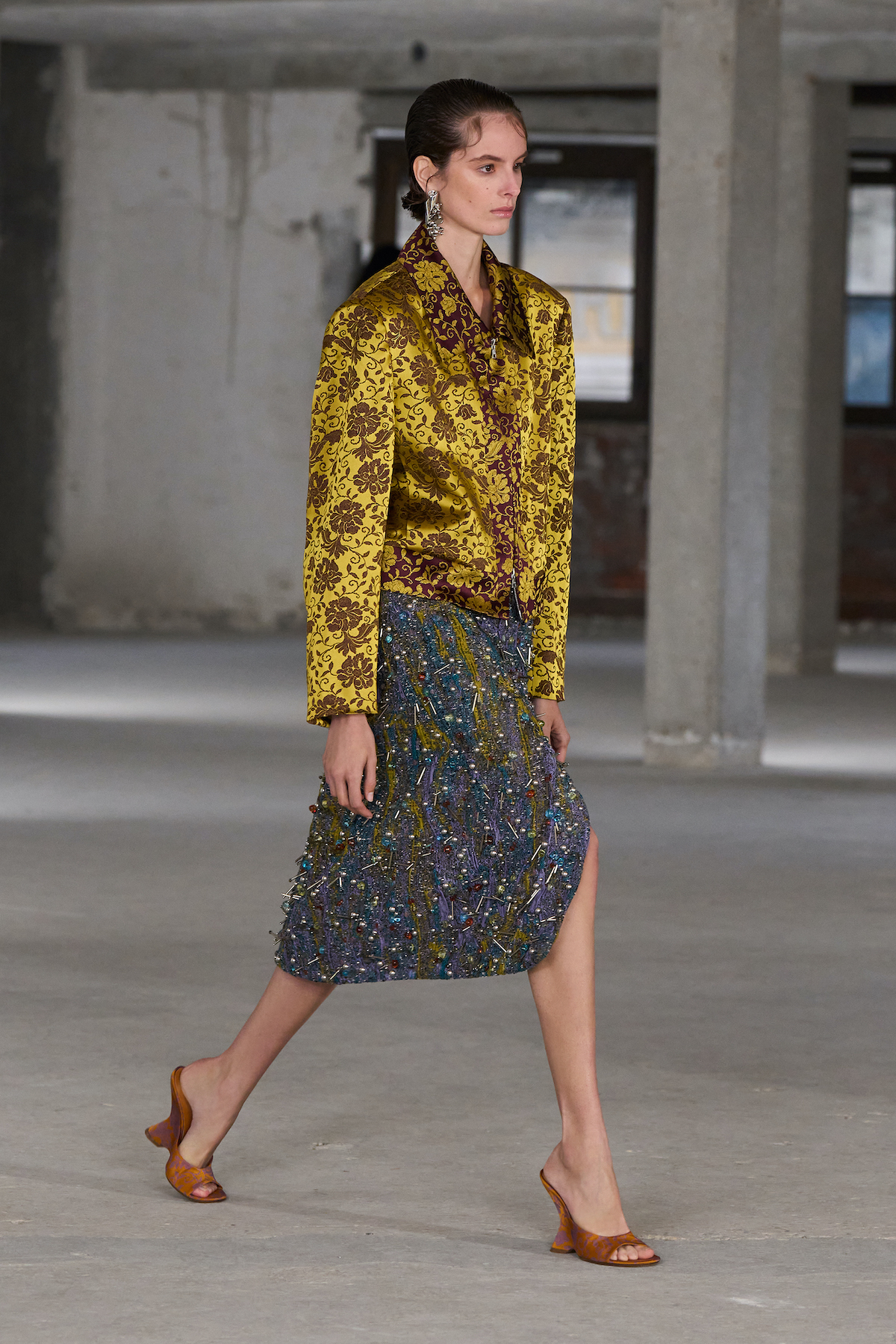
The first collection since Dries Van Noten exited his eponymous brand in June of this year was a respectful outing from his Antwerp-based design team, which recalled hallmarks of the designer – an act of ‘assessing, admiring and reinterpreting,’ as the collection’s accompanying notes described. So there were lush, sequinned overcoats, diaphanous silk skirts and dresses, louche, mannish tailoring, and moments of romantic embellishment, while an opulent palette (spanning earthy browns to vivid shots of orange, lime green and turquoise, inspired by an archive S/S 1997 collection) met clashing prints, from rich florals to those evocative of animal skins. Described by the brand as ‘the freedom of wandering for a brief time’, this nonetheless satisfying collection couldn’t help but pique the interest of what’s next for the Belgian label – and whether a new designer is already waiting in the wings.
Courrèges
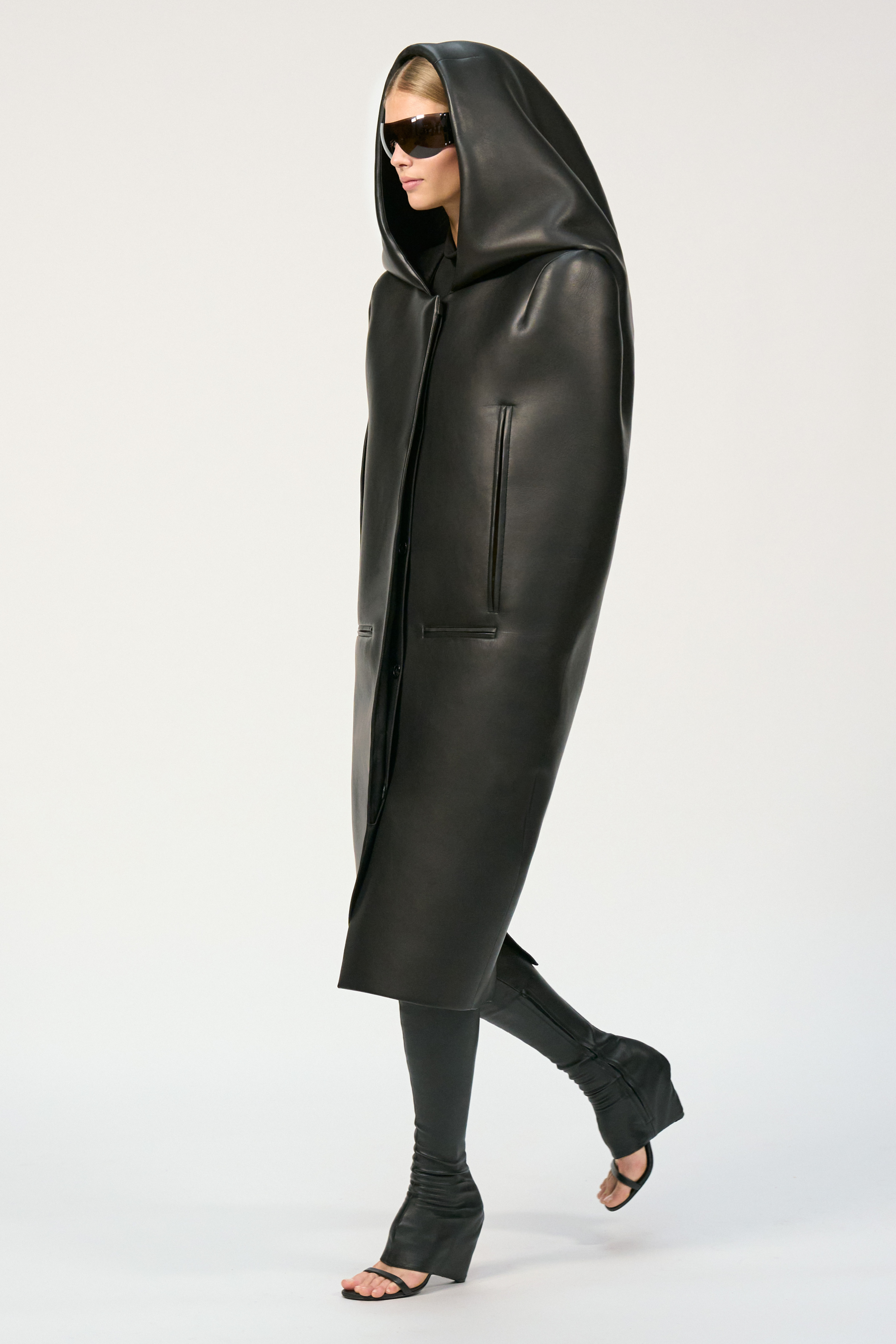
Nicolas Di Felice’s latest Courrèges show took place around an enormous tilting disk, over which thousands of tiny balls moved back and forth (in the early morning slot, its effect was akin to meditation). The designer said that he was interested this season in the idea of the ‘infinite loop’, an inspiration point hinted to by the show’s invitation, a Möbius band, cast in metal. ‘Repetition, revolution, renewal,’ the Belgian designer described, a maxim which was encapsulated in the show’s opening look, a hooded neoprene cocoon coat in which the model’s hands were encased inside. Its inspiration was a 1962 haute couture cape by Andre Courrèges, which here Di Felice channeled through the collection in garments which could be slipped on as a single garment, though appeared like two (a bandeau bra top and halterneck dress, for example). Elsewhere, the designer honed his sleek, sexy vision for Courrèges in bonded tailoring, sliced denim, and rectangular bra tops which seemed to hover magically across the models’ chest, an act of sartorial ‘architecture’ (as Di Felice described) which continued over the collection’s closing looks.
Saint Laurent
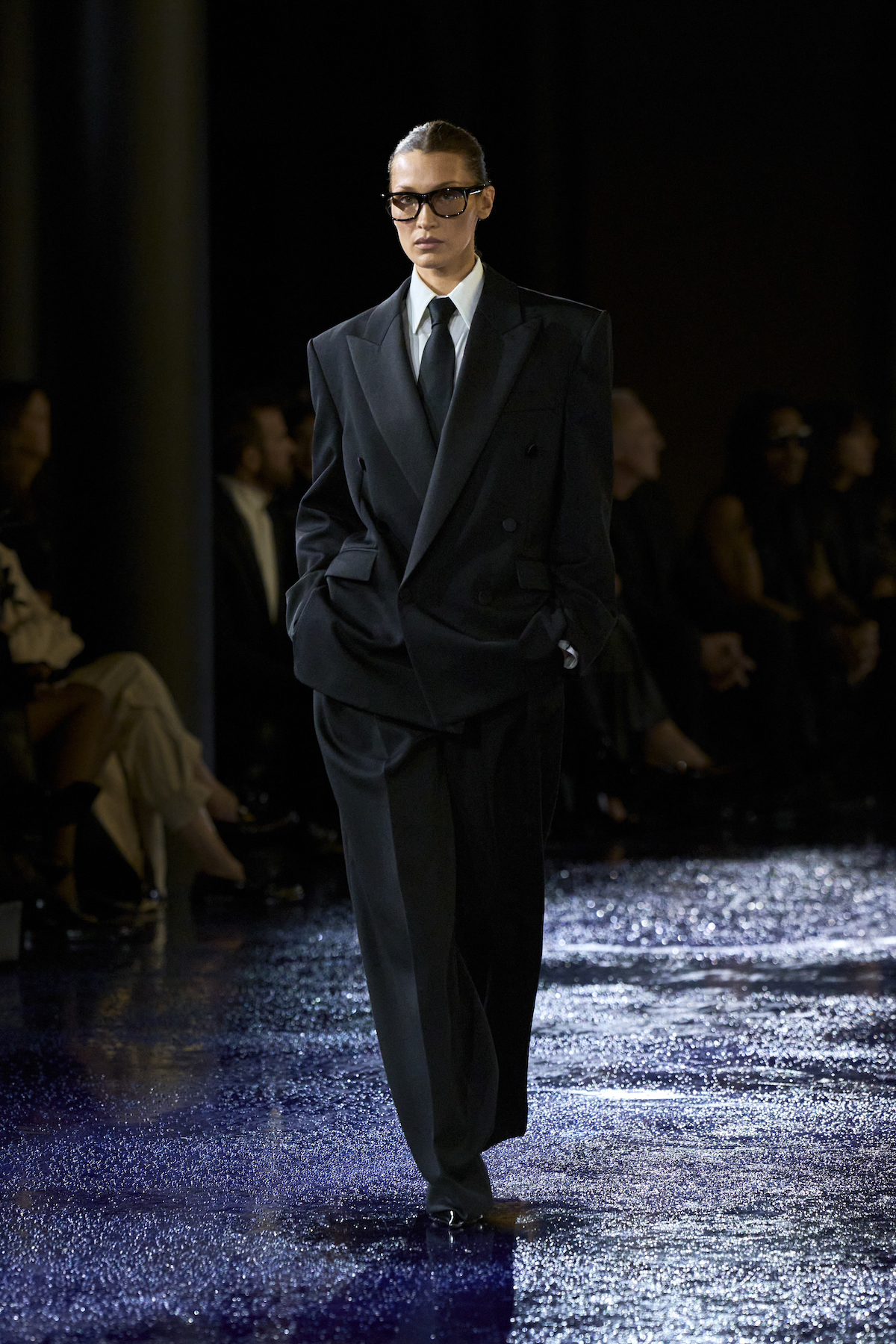
Anthony Vaccarello selected Saint Laurent’s Rue de Bellechasse headquarters on Paris’ Left Bank to stage his latest collection, a location he held his first-ever show for the house eight years prior – a full circle moment, and a relative lifetime in the merry-go-round of designers at fashion’s major houses. The runway was circular too: a monumental golden circle, open to the elements (drops of Paris rain drizzled through as the show took place) and hovering over a vivid blue runway. Vaccarello said he chose the colour to evoke the blue of the Yves Saint Laurent gardens in Marrakech, the house founder’s adopted home city.
It set the stage for a collection that saw Vaccarello pay ode to Yves Saint Laurent in his most direct manner yet, evoking the designer’s own personal uniform – a wide-cut, fluid tailored suit, usually double-breasted and worn with a tie – with a trail of gender-swapped Saint Laurent doppelgangers (Bella Hadid, who made a much-anticipated runway return after a two-year hiatus, even wore his signature glasses). Meanwhile, the other half of the collection sought to evoke the opulent Saint Laurent woman in her various guises: a boho ruffled dress slung with wooden beads, opulent jacquard blazers and flourishes of lace, all in rich, seductive tones as if plucked from a jewellery box. Eight years on, it made for one of Vaccarello’s most desirable collections yet: an exercise in tailleur and flou which saw the house’s past rewritten in the Belgian designer’s singular and sensual design vernacular.
‘No other house is as linked to a quintessential female archetype as Saint Laurent, whose ideal woman is more complex than the seductive perfection of classic muses,’ said Vaccarello via the collection notes. ‘As Yves Saint Laurent could have said: I am the Saint Laurent woman.’
Dior
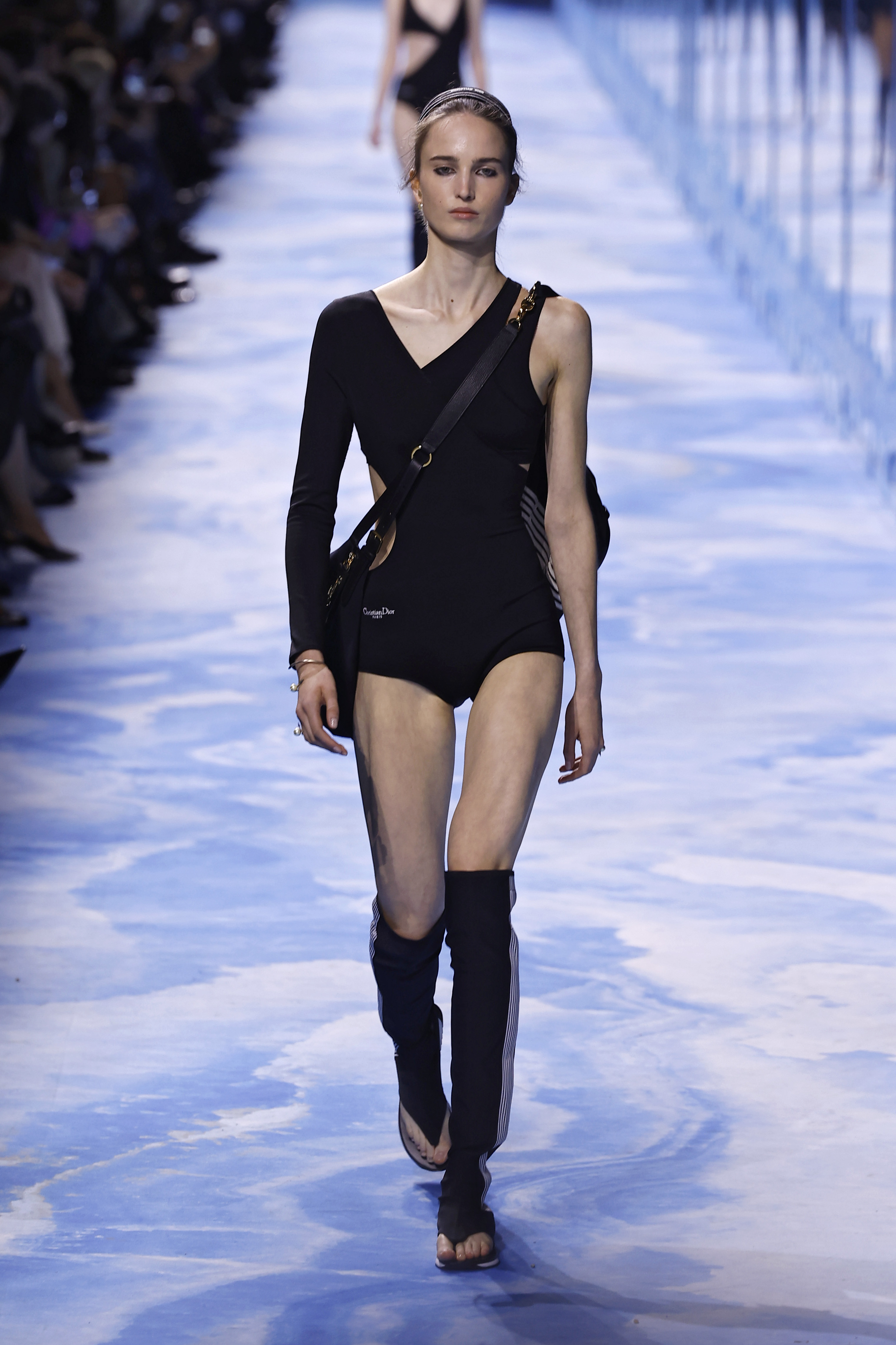
The roots of Maria Grazia Chiuri’s latest ready-to-wear collection for Dior could be found in her A/W 2024 couture show, held earlier this summer in the grounds of Paris’ Musée Rodin (the location also served as the site of this afternoon’s show, a shift from its usual venue in the Tuileries). Back then, Paris was on the precipice of an Olympic summer, with Chiuri looking back to the classical roots of the games in Ancient Greece, riffing on the ‘peplos’, a garment from the era which is made from a singular piece of cloth and folded at the waist. For her S/S 2025 ready-to-wear collection – teased with a video of the designer being given a tour of the Louvre’s Roman Antiquities gallery – she looked once again to the ancient era, summoning the mythological Amazons, a tribe of female warriors who appeared in epic poems from the Argonautica to the Iliad (men were not allowed in the Amazons, while any sons born to them were handed back to their fathers). The link to the historic house was Christian Dior’s Amazone dress from his autumn-winter 1951-1952 collection, a cut that was inspired by a group of French female horseriders (‘Amazone’ derives from the Gallic word for ‘side saddle’). Chiuri said the dress is symbolic of ‘a strength of spirit, a reference point for the notion of an autonomous, courageous femininity’.
It was a thematic choice that fits well with Chiuri’s vision for the Parisian house, which is focused on creating clothing for – and inspired by – empowered women, nonetheless infused with moments of mythological grandeur and romance. The show began with an appearance from Sofia Ginevra Giannì, aka Sagg Napoli, a multidisciplinary Italian artist and archer, who, bow slung over her shoulder and wearing a riff on the gladiator’s uniform, walked the runway before setting up in a Perspex corridor and firing shots on an eye-shaped target (the artist had also created the show’s set). The looks that followed continued a sleek, sporty mood: there were criss-crossing asymmetric bodysuits and dresses, evocative of swimwear, elongated mesh dresses, lace-up boxing boots and sneakers, go-faster stripes and racing grid motifs, while later in the show utility nylon shirts and protective bodices recalled professional shooters and archers. Meanwhile nipped-waist tailoring – largely styled off the shoulder to reflect the collection’s asymmetric line – layers of sheer organza and tulle, plissé dresses and glimmering tassels added the requisite feeling of romance that remains at the heart of the house of Dior. The result, said Chiuri, was an exploration of the relationship between body, movement and dress, and in doing so provided a link to her first-ever collection for the house nearly a decade prior, in 2016, which was inspired by female fencers and their uniforms.
Stay tuned for more from Paris Fashion Week S/S 2025.
